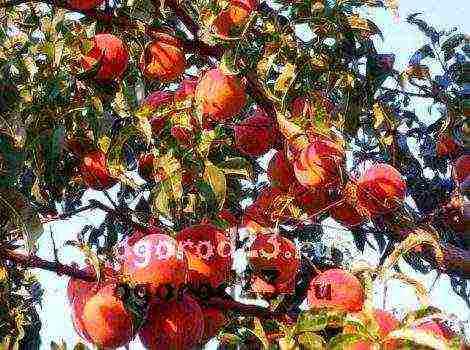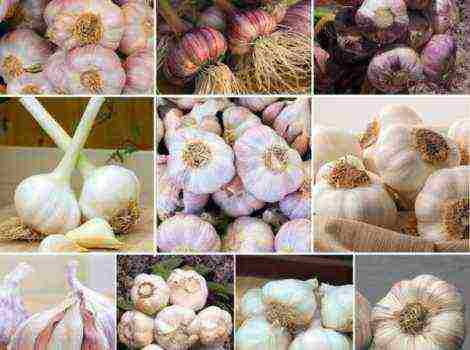Content
- 0.1 Variety Variety - mid-season black currant
- 0.2 Black pearl or Pearl - medium-early large-fruited
- 0.3 Selechenskaya-2 - early fruiting
- 0.4 Black boomer - early harvest from Kharkov
- 0.5 Big Ben - early variety, super yielding
- 0.6 Pygmy - medium early
- 0.7 Raisin - early variety
- 0.8 Gulliver - early maturing
- 0.9 Summer resident - early ripening variety
- 0.10 Titania is a mid-season variety
- 0.11 Dobrynya is a mid-season variety
- 0.12 Bagheera - mid-season
- 0.13 Black currant is the sweetest - Green haze
- 0.14 Nina is an early sweet variety
- 0.15 Bagheera is a mid-season sweet variety
- 0.16 Constellation - early ripening variety
- 0.17 Maria Kievskaya
- 0.18 Nestor Kozin
- 0.19 Exotic
- 0.20 Perun
- 0.21 Dubrovskaya
- 0.22 Crane
- 0.23 Venus
- 0.24 Bummer - late-ripening variety
- 0.25 Arcadia
- 0.26 Vologda
- 0.27 Altai Late
- 0.28 Tatyana's Day
- 1 Distinctive features of currant varieties
- 2 About the features of black currant
- 3 Ripening classification
- 4 We take into account the criterion of "self-fertility"
- 5 The best varieties for the Moscow region
- 6 Choosing currant varieties for the Urals
- 7 The best currant for Siberia
- 8 "Hits" of varieties of large-fruited black currant:
- 9 The best varieties of black currant and their differences
- 10 Large-fruited varieties of black currant
- 11 Sweet varieties of black currant
- 12 Early varieties of black currant
- 13 Late, large varieties of black currant
- 14 Conclusion
Currant is a tasty and very healthy berry, unpretentious in cultivation and distribution. It is not difficult to cultivate currants, and in order to collect stable good yields on time, you need to choose the right variety that suits you.
Let's look at the possibilities of modern breeding and get acquainted with the varieties offered by breeding institutes. Here are the characteristics of various varieties of currants with photographs and descriptions.
Black currant varieties with large berries
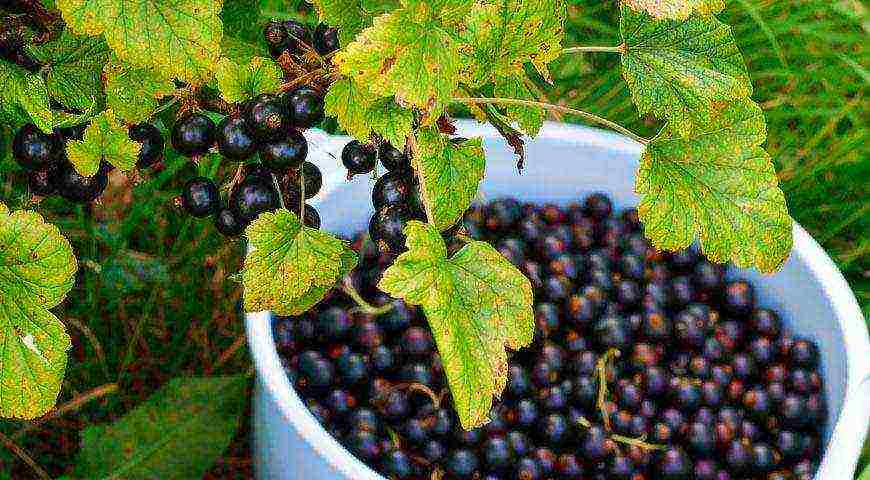
Large varieties of currants attract high yields. Often the berries of these varieties form clusters similar to grapes. In return, they require high-quality cultivation, fertilization, watering, attention and care.
Most large-fruited varieties do not form large enough berries without watering, give reduced yields.
Also, due to the large size, the question arises about the safety of the whole berry. The strength and density of the peel must withstand the pressure of the juice when pouring the berries, as well as ensure keeping quality during transportation and storage.
For the cultivation of large-fruited bushes, agricultural technology is important. The soil under the bushes for the season significantly consumes the supply of nutrients for growing crops.
Also, it is important for large-fruited varieties - that the growth of pagon branches does not lag behind fruiting.
In order for the harvests to be stable and annual, timely replacement of the branches of the bush is necessary. Currants bear fruit well on those shoots, the annual growth of which is at least 25 cm. Therefore, branches with a weak growth, the age of which exceeds 4-5 years, must be cut off.
The selection of large-fruited varieties should also take into account the time of maturation of the variety and harvest. Early - bear fruit at the beginning of the month of July. Medium - after the middle of the month, late - in August.
And now, according to the list of varieties and their description, let's see which variety of black currant is the largest and sweetest?
On a note: all varieties described below are winter hardy.They tolerate frosts and prolonged cold weather well, cope with spring return frosts. Therefore, we will not further indicate the characteristics of winter hardiness for each variety separately.
Variety Variety - mid-season black currant

A variety with large berries weighing up to 6 g. Berries are collected in clusters of 8-10 pieces. Thus, the weight of one brush can reach 60 g. And 20 good brushes can make up more than 1 kilogram of the crop.
The yield indicator is 6 kg of berries per bush per year. Their taste is sweet with sourness (they contain 9% sugar and only 3.5% acid - for comparison, in sweet varieties of sugars there is almost the same amount - from 10%), the peel is dense. Bushes grow up to 1.5 m in height.
Yadrenaya is a well-deserved record holder among varieties of large black currants. She needs annual rejuvenation. The branches are severely depleted during the fruiting season, therefore they require cutting and replacement with new pagons.
What you need to know the disadvantages: the different size of the berries, their size may vary. Another drawback is that the bush is aging and requires replacement after a few years. The number of years of good fruiting depends on the quality of the care. With good soil and sufficient watering, the bushes can retain their yield for 6-7 years.
Black pearl or Pearl - medium-early large-fruited
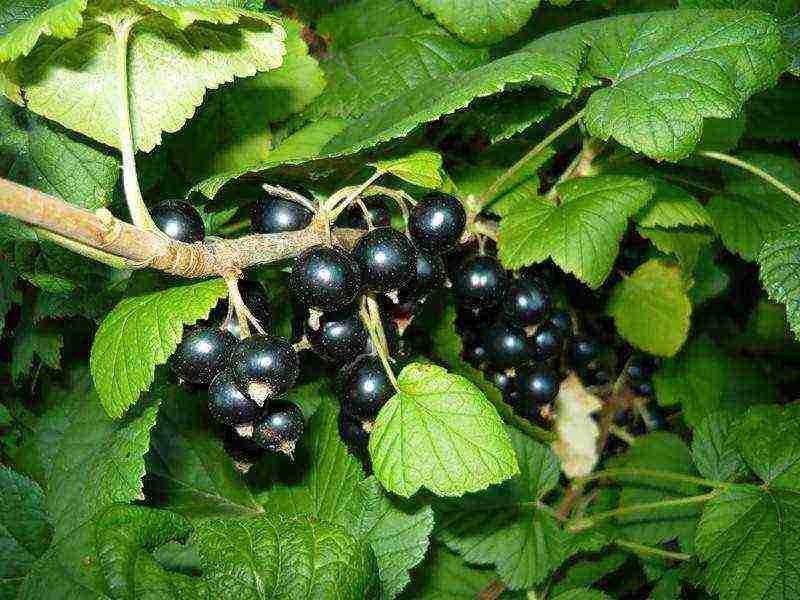
Another record holder who received the title of "Masterpiece of Russian selection". Brought to VNIIS Michurin. Fruits in berries weighing up to 6 g. Taste is sweet with a slight sourness (contains 9.5% sugars). Yields up to 5 kg of berries from each bush.
The name of the variety is associated with the characteristic "pearl" luster. The dense rind ensures keeping quality and the so-called "dry" pull-off. Berries of the Black Pearl are perfectly transported.
The shrub of the variety is distinguished by vertically growing branches, the height of the bushes is up to 1.3 m.Without snow cover, without damage to the future harvest, it tolerates frosts down to -42 ° C. At the same time, it tolerates heat and sun up to +40 without shading.
The advantages of the variety are a good harvest in any year, resistance to mites.
The disadvantage of the variety is that the variety tastes sour, not always resistant to pests, fungal diseases.
Selechenskaya-2 - early fruiting

The weight of the berries reaches a maximum of 6 g, they have a sweet and sour taste (7% sugar in the berries) and a dense peel (provides the so-called dry separation and keeping quality). Strong aroma.
There are 10-15 berries per cluster. Very tall dense bushes - up to 2 m, yield up to 5 kg of berries per fruiting season.
Advantages: resistance to both cold and heat and lack of moisture. Not affected by dew.
Disadvantages - the variety requires good care, fertilized soil, and sufficient nutrients. Poorly resistant to pests.
Black Boomer - early harvest from Kharkov
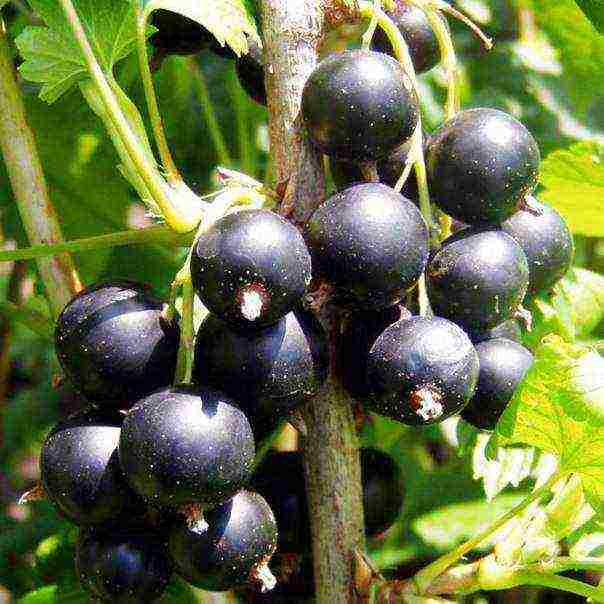
The weight of the berries is large, up to 7 g. Collected in a bunch resembling grapes, up to 10 berries in each bunch. The bush is upright and compact, yields up to 4 kg of berry harvest per year.
Advantages: uniformity of ripening and uniformity of berries. Do not crumble after ripening. Stable fruiting every year. Resistance to fungal and other diseases.
Disadvantages: with heavy rains and a lot of moisture, the berries may crack. Pick-off is not always dry.
Big Ben - early variety, super yielding
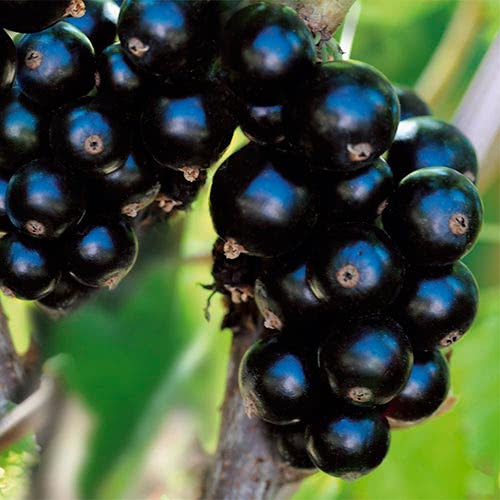
Another variety, the name of which speaks for itself.
Average weight of berries - up to 4 g. The yield of one bush can reach 10 kg (with good care). The taste is sweet and slightly sour, with sweetness prevailing over acid.
Advantages: after ripening, the berries do not crumble. Resistant to frost and powdery mildew.
Disadvantages: exactingness to care - obligatory pruning, fertilization, watering.
Pygmy - medium early
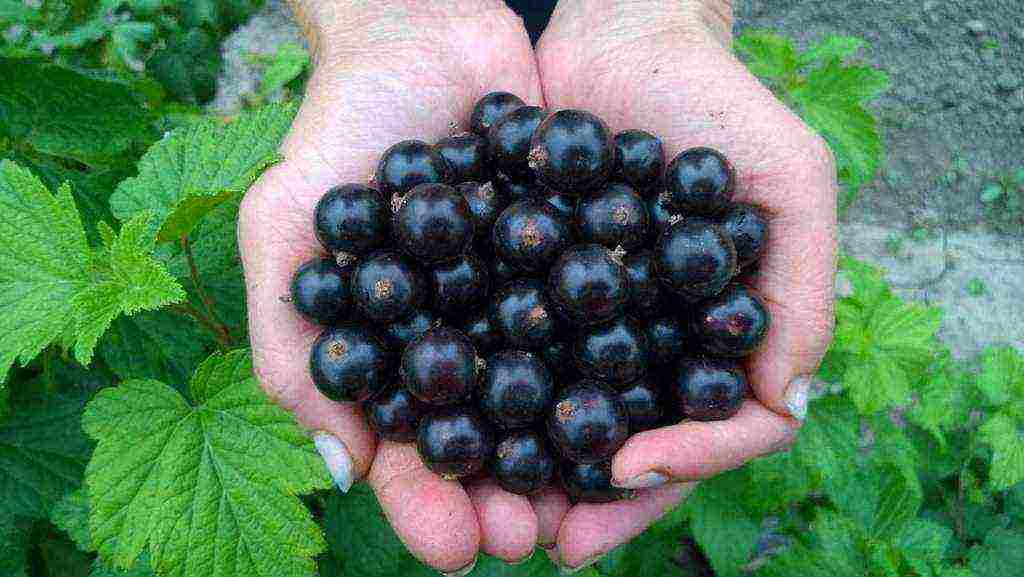
Berries weight up to 8 g, up to 10 pieces per brush. Even over time, with the aging of the branches, the berries retain their large size. The taste is very sweet, it contains 9.5% sugars. The bushes grow up to 2 m high, but the branches are compact, so they do not take up much space.
The variety gives up to 7 kg of berries per season from a bush.
Advantages: the variety is capable of self-pollination and high yields. The bushes are resistant to powdery mildew. Their winter hardiness is determined by thick stems and a large supply of nutrients, it is -35 ° C.
Disadvantages: low resistance to tick and septoria infection.
Raisin - early variety
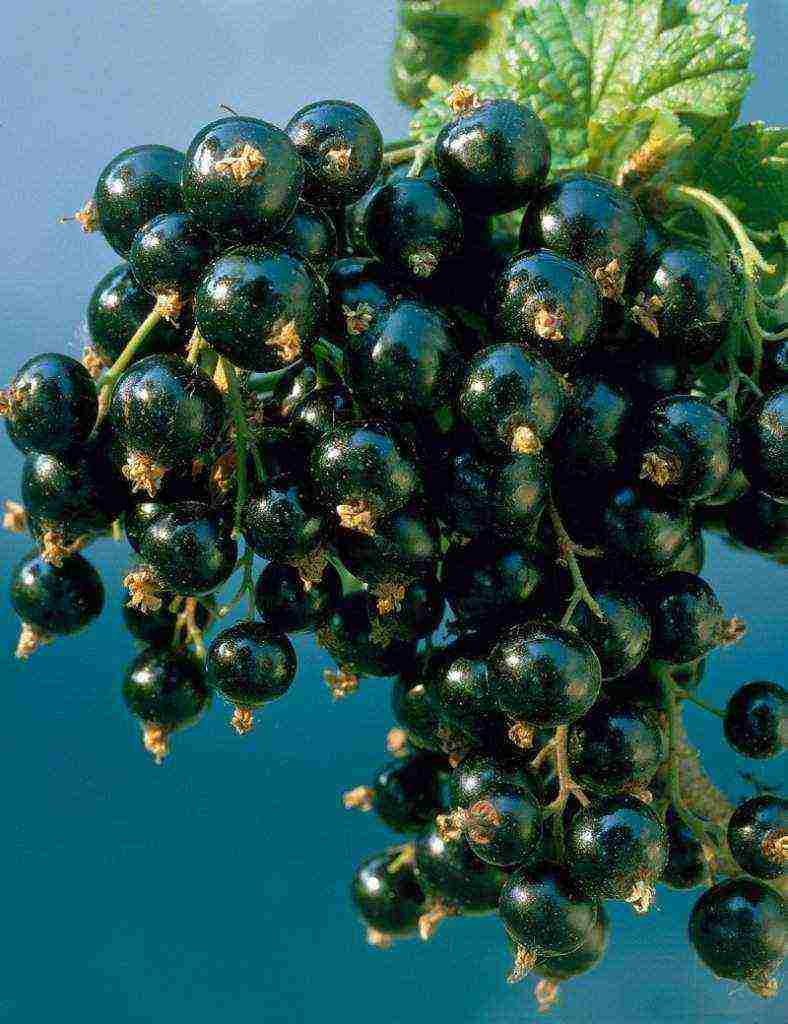
The name of the bush is due to the fact that after ripening the berries do not crumble from the bush, remain on the branches, wither and turn into a kind of raisins. This is the exclusive properties of the raisin variety.
Berries differ in average weight - up to 4 g, in a brush there can be 10-12 sweet berries, in which up to 9% of sugars. Productivity - average, 3.5 kg per bush. The direction of growth of pagons is upward. Thanks to this feature, bushes can be planted denser than usual.
Ripening period - early. The taste is sweet.
Advantages: winter hardiness and resistance to heat, fungal infections, ticks.
Disadvantages: poor rooting, bushes of this variety are more difficult to propagate by cuttings, unlike most traditional black currant varieties.
Gulliver - early maturing
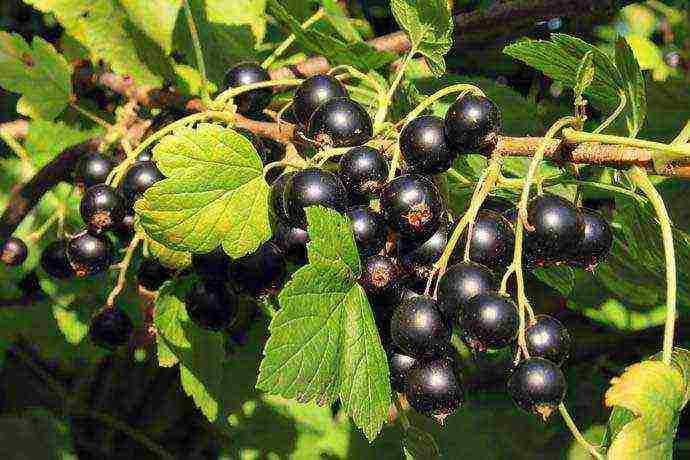
The weight of Gulliver berries reaches 5 g. Considering that there can be 20 berries in the bunch of this variety, the weight of the bunch turns out to be weighty - up to 100 g. The taste of berries is rich, with a well-felt sourness. Sugar in berries 6.5%. The bush is tall and leafy, yields up to 2 kg per year.
Advantages: the variety is resistant to very severe cold and long spring frosts. Resistant to kidney mites.
Disadvantages: picky about light, bears fruit well in open sunny places when watering. Lack of water is reflected in a decrease in the amount of crops.
Summer resident - early ripening variety
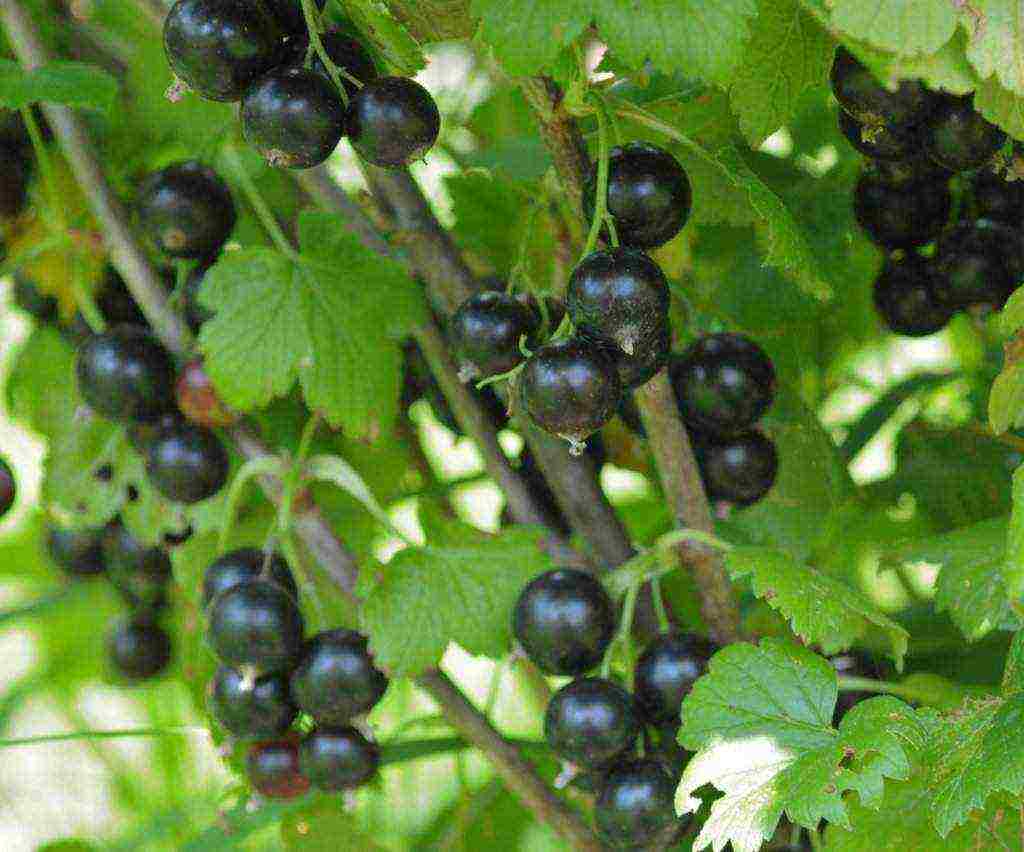
The size of the berries is large enough - up to 5g, very sweet, contain 9.3% sugars. The total yield of the bush is average, up to 1.5 kg of berries per year. The bush is undersized, withstands frosts down to -35 ° C.
Advantages: high self-fertility (more than 70%, in most varieties - about 50%, and this is considered a good indicator).
Disadvantages: due to the short stature, the branches during the ripening of the crop can bend low to the ground and touch the ground. Therefore, props and timely harvesting are needed. Berries not picked on time quickly crumble. The fruits ripen unevenly.
Titania is a mid-season variety

Despite the name, the variety bears fruit with medium-sized berries. The weight of each berry does not exceed 4 g. However, with a large number of berries in the bunch (up to 25 pieces), the yield of the variety is quite high - 4 kg per bush per fruiting season.
The taste is traditional sweet and sour (there are not so many sugars, only 6.5%). Another feature of the variety is that the berries ripen in batches within 3 weeks. Which is convenient for home assembly and inconvenient for a mechanized one.
The advantages of the variety: resistance to cold climates and diseases, tolerates frosts down to -24 ° C without loss of yield, does not choke when harvested.
Disadvantage: the variety requires good care - fertilizers, watering, pruning, timely replacement of bushes.
Dobrynya is a mid-season variety
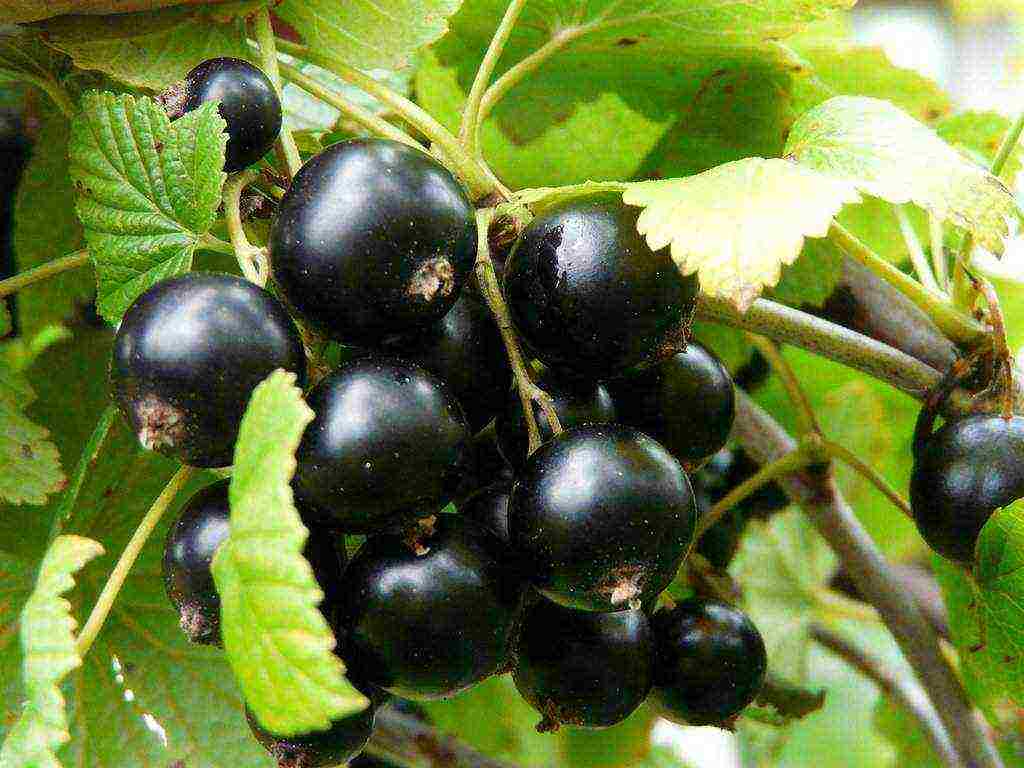
A fairly large variety with a weight of each berry up to 7 g. Each cluster contains 8-10 berries. Up to 3 kg of harvest is harvested from each bush. Sweet and sour taste with an average sugar content of 7%, dense peel provides transportability and shelf life.
The height of the bush is up to 1.7 m with a compact, non-spreading crown. This makes the variety popular for summer cottages in small, confined areas.
Advantages: high winter hardiness, not afraid of long and severe frosts, resistance to adverse factors - drought, powdery mildew, without loss of yield.
Disadvantages: different sizes of berries, exactingness to care, low resistance to fungal diseases.
Bagheera - mid-season
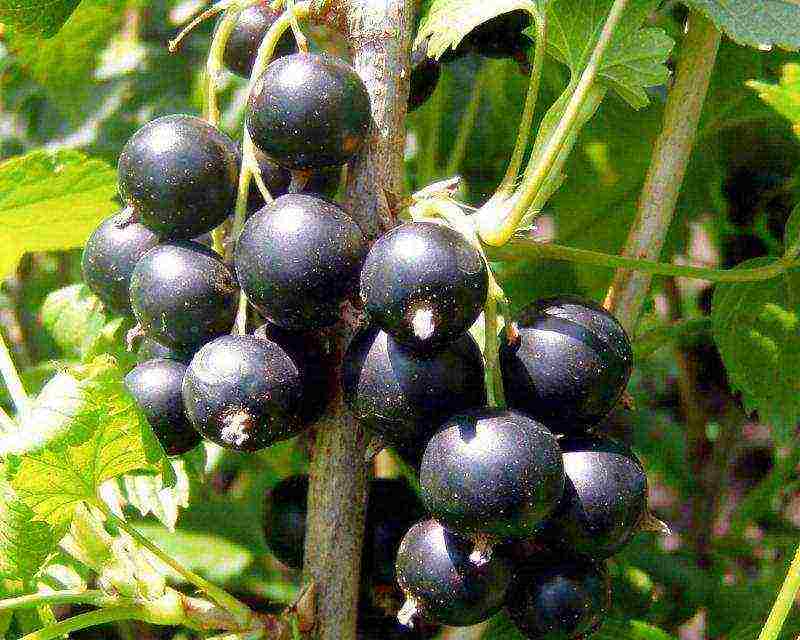
Berries weighing up to 7 g, 7 pieces per brush. Very sweet, contains 12% sugar. The bushes are tall, reaching 2 m. With good care, 4.5 kg of berries are harvested from each bush.
Advantages: the variety is equally adapted to cold and heat, frost and drought, suitable for growing in a harsh continental climate. And also resistant to pests.
Sweet black currant varieties
Sweet currant varieties contain more than 10% sugars. However, they also contain vitamin C (ascorbic acid). The amount of vitamin C determines the sourness of the variety - whether it will feel strong, or weak, barely noticeable.
As a rule, sweet blackcurrant varieties have almost no sour taste. Therefore, they represent a tasty prey for wasps. For such varieties to ripen, natural protection is needed - a dense peel on the berry. Otherwise, the crop will be stably destroyed by wasps.
The sweetest varieties of black currants contain more than 12% sugars. Their taste resembles grapes, and the sweetness is provided by the name of the varieties - dessert. For information on the characteristics of black currants (different varieties: super large, sweet and fruitful) - see below on the description and photo.
Black currant is the sweetest - Green haze
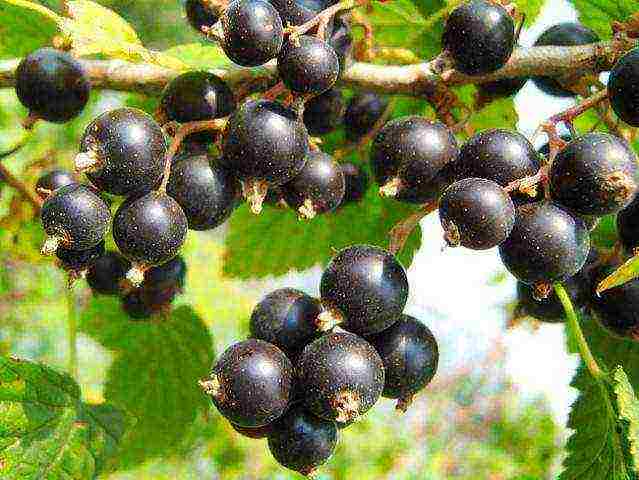
A short bush, the berries of which contain up to 13% sugars. Ascorbic acid in them - 200 mg per 100 g.
The size of the berries is medium, up to 2.5 g. High yield of the bush - up to 7 kg of berries per season.
Disadvantage: poorly resistant to ticks.
Nina is an early sweet variety
The variety, in the berries of which up to 11% sugars and up to 270 mg 100 g of vitamin C. Berries up to 4 g, bushes stably bear fruit up to 4 kg over the summer. They are demanding for watering, in which they grow berries twice as large - up to 8 g each. Moreover, all berries are the same size. Easily propagated by cuttings.
Disadvantage: poor transport stability.
Bagheera is a mid-season sweet variety
A variety in which up to 12% sugar and up to 190 mg 100 g of ascorbic acid. The characteristics of the variety are given above, we will repeat them. Berries weighing up to 7, bush yield up to 4.5 kg. Ripen at once, suitable for farming.
Disadvantage: low resistance to dew and pests.
Constellation - early ripening variety

The weight of the berries is small, reaching 1.5-2 g, the sweet taste is provided by 11% of sugar in the pulp. The total yield is also average - about 2.5-3 kg per bush.
The bushes are medium-sized and slightly spreading. Branches are of medium thickness.
Advantages: the ability to bear fruit even without watering. Bushes give 3 kg of berries, even in the "worst" for growing, dry seasons. Also important: self-fertility, winter hardiness, resistance to pests and diseases.
Disadvantages: poor resistance to kidney mites.
Early varieties of black currant
Ripe berries are yielded in early July, and in the southern regions - in the middle and second half of June. For early varieties, spring frost resistance is important. They wake up early (at least April), bloom (usually in May) and more than other medium and late varieties suffer from recurrent frosts or spring cold snaps.
The early maturing varieties Dachnitsa and Selechinskaya were described above. Here are the characteristics of other varieties.
Maria Kievskaya
Berries up to 4 g, sweet and sour. Used for processing and freezing. Medium-sized spreading bushes.
Advantages: resistance to one of the common diseases of shrubs - rust, resistance to powdery mildew.
Nestor Kozin
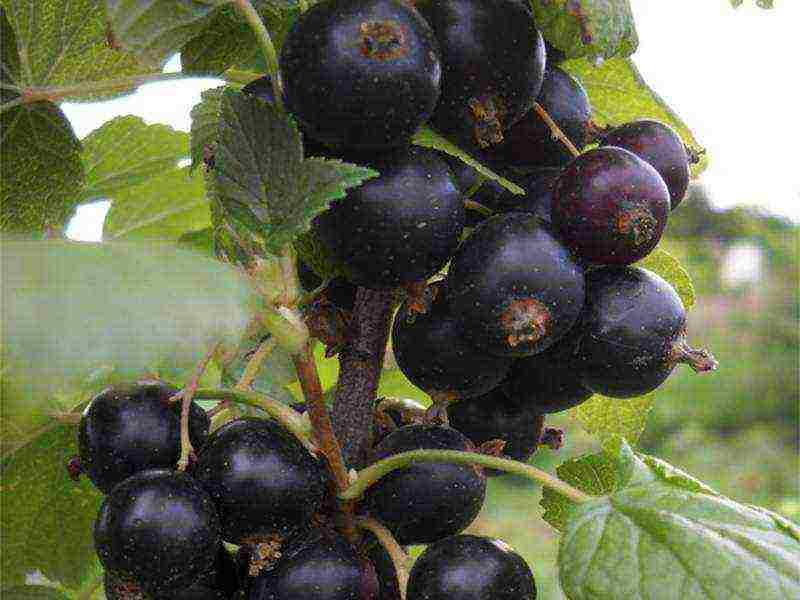
Berry up to 4 g, sweet. The height of the bush is up to 1.5 m.
Advantages: resistant to frost, heat, powdery mildew.
Exotic

Berries up to 3 g with a sweet and sour taste. They grow on medium-sized bushes with a yield of 1.5-2 kg per year.
Advantages: bushes are not prone to thickening.
Advantages: resistance to the appearance of powdery mildew, resistance to winter cold. The keeping quality of the berries after picking.
Disadvantages: relatively low yield - up to 1 kg per bush.
Perun

Berries weight up to 2 g. Collected in a brush of 10-14 berries. Harvest from a bush - up to 2 kg. The taste is sweet with a slight sourness, 9.5% sugars, and a very strong aroma.
Advantages: resistance to winter and return frosts, to heat.
Disadvantage: it suffers greatly from powdery mildew, requires a garter of branches on a trellis.
Medium black currant varieties
Medium varieties ripen in late June and early July. Medium late - the second decade of July. They are popular due to the content of a large amount of nutrients. Among the representatives of mid-season varieties - the bestsellers Yadrenaya, Dobrynya, Izyumnaya.
Here are a few mid-season varieties.
Dubrovskaya
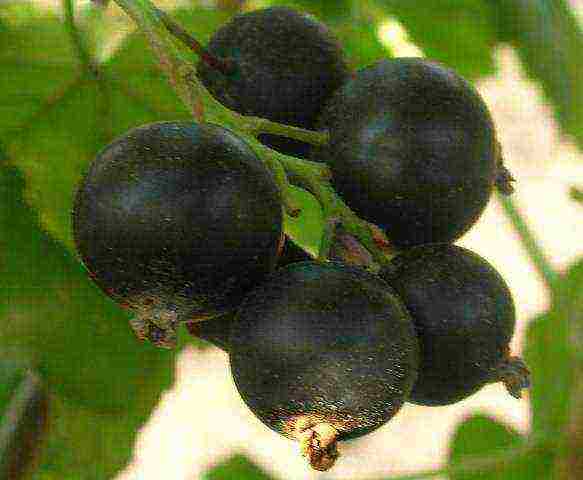
A variety that combines a high yield per bush (up to 3 kg) and its small compact size. Therefore, it is ideal for small summer cottages. The weight of the berry on the bush reaches 2.5 g, the taste of the berries is sweet and sour (they contain 7% sugars).
Advantages: resistant to cold weather, mites and terry.
Disadvantages: the bushes are prone to thickening, often affected by powdery mildew.
Crane
Berries of medium size (up to 1.5 g each), quite sweet in taste (contain up to 10.5% sugars). Sprawling bushes, yield up to 4 kg per year.
Advantages: the berry is dense, transportable, suitable for mechanized harvesting.
Venus
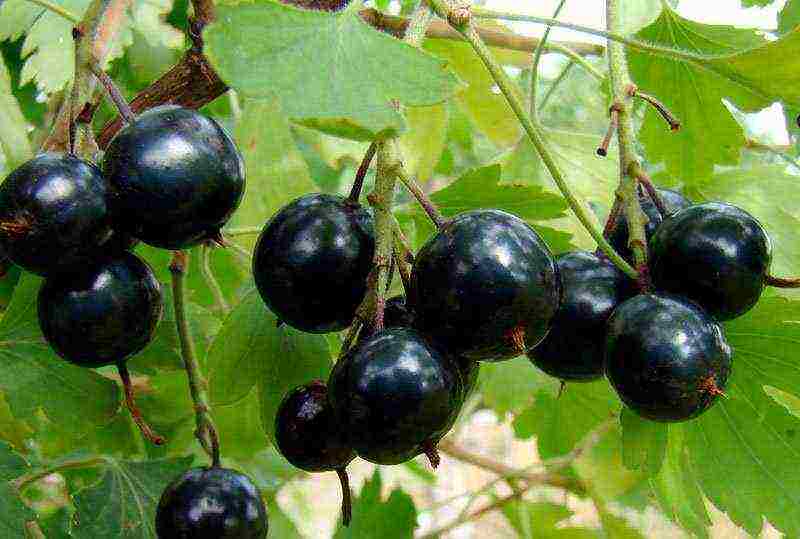
Berries up to 6 g, in a brush up to 10 berries, contain about 7% sugars - sweet and sour taste. Collect up to 5 kg from the bush. Good winter hardiness and drought resistance. Grows well and bears fruit in partial shade.
Advantages of the variety: begins to bear fruit early and extends the fruiting time to August.
Disadvantage: low resistance to mites, septoria and hazel grouse. Poor transport stability.
Late varieties of black currant
Ripen in early August. Often they are affected by fungi, pests due to prolonged aging. Therefore, for late varieties, resistance to diseases, pests, resistance to heat, and lack of water in the soil are important.
For a long time of ripening, throughout the season, the bushes are exposed to various "misfortunes". They must successfully survive the lack of moisture, release new pagons and grow a consistently high berry yield.
Also important: for long ripening, the berries need a dense peel. It shouldn't crack. Such berries are excellent for transportation, they are not damaged during mechanized picking. It is also convenient to freeze them. Here are the characteristics of popular late-ripening varieties.
Bummer - late-ripening variety
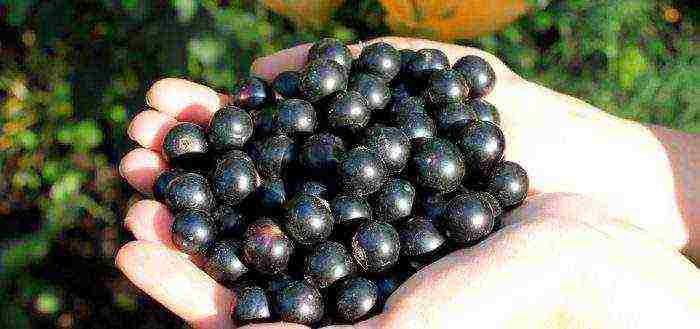
Berries up to 3 g, sweet (more than 9% sugar), collected in medium-sized clusters, 8-10 berries each. The yield indicator is average - 2.2 kg of ripe berries from a currant bush per season. The bushes themselves are tall, dense, medium spreading.
Features of agricultural technology - suitable for mechanized assembly.
Advantages: frost resistance and resistance to pests, fungal diseases, except for dew.
Disadvantages: instability to powdery mildew, gradual ripening, unstable yield.
Arcadia
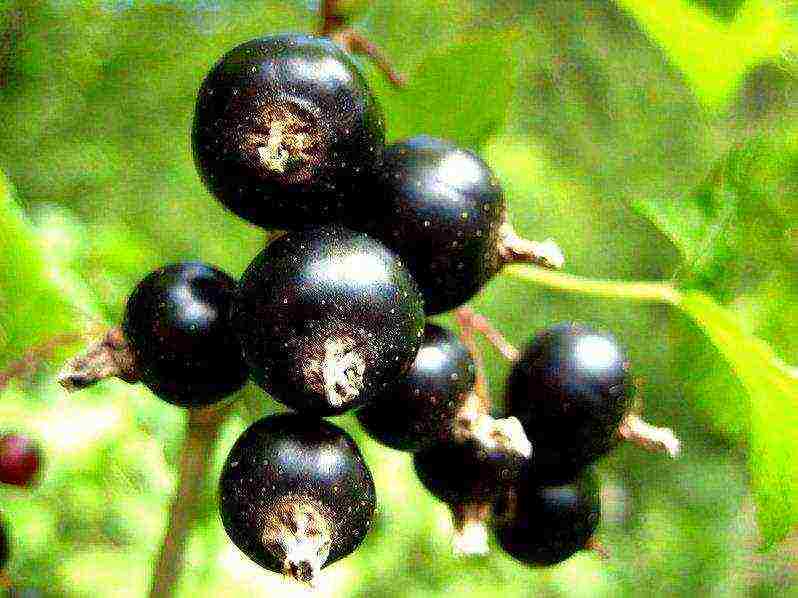
A variety with rather large sweet and sour berries, the weight of which reaches 5 g. The yield per bush is average and is 2.5 kg. The bush is 1-1.2 m with curved branches.
The variety has a disadvantage, traditional for low bushes: under the weight of the crop, the branches fall to the ground.
Vologda
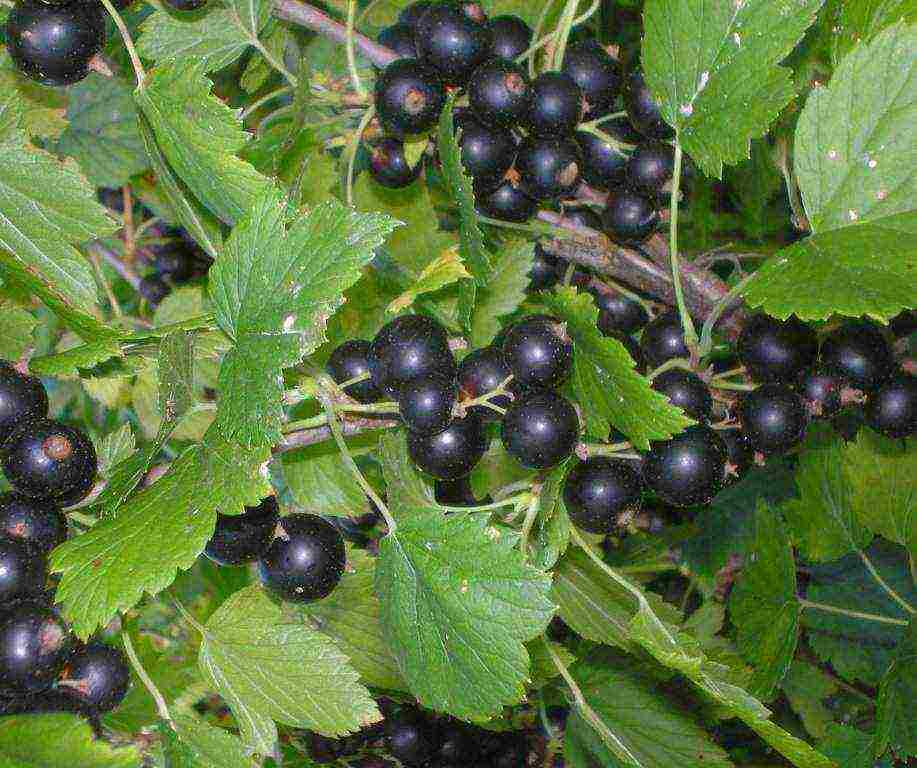
Yield leader among late varieties. Yields 5 kg of berries from a bush, the weight of which is more than 2.2 g. Berries grow in clusters of 40 for easy harvesting. Sprawling bush, withstands cold up to -35 and heat up to +45.
Disadvantage: Prone to rust, uneven maturation, requires garter.
Altai Late
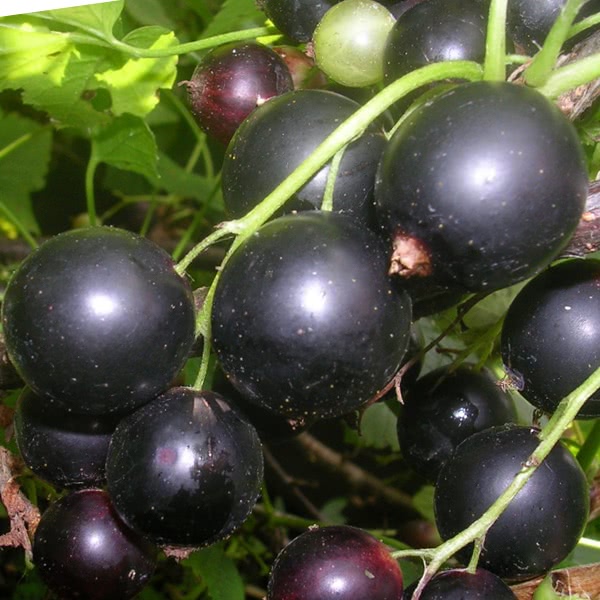
Produces berries of medium size - up to 1.2 g in weight, collected in 10-14 pieces per cluster. The sweetness of the taste is provided by 8% sugars.
The variety is resistant to various fungi and pests, except for powdery mildew.
Tatyana's Day
Sufficiently sweet (9.5% sugar) and medium-sized (up to 1.5 g) berries. Up to 3 kg of harvest ripens on the bush. Suitable for mechanized assembly.
Disadvantage: not resistant to spider mites and powdery mildew.
Black currant berries contain a huge amount of vitamins. The bushes of the plant are found on every personal plot, the berry is rightfully popular.There are so many varieties of it that for each climatic region a suitable one is selected according to its characteristics. Let's try to figure out together what is the best variety: black currant - 15 varieties - large-fruited, high-yielding.
Each of the varieties has special characteristics. And only comparing them, it becomes possible to dwell on the right choice, determining one or another berry variety for cultivation in your garden. It takes into account the timing of ripening, differences in taste, the thickness of the berry skins, resistance to the hot season, the ability to endure frosty winters, resistance to diseases and harmful parasites.
Today, more than two hundred varieties are known that are suitable for cultivation in different regions of Russia. Choosing the most suitable variety for growing is always difficult, because there are quite a few of them. In this case, it is recommended to plant three to four species that differ in terms of ripening. This will allow you to increase the period of fruiting and determine which species is more tasty in its qualities and feels better in your garden.
Distinctive features of currant varieties
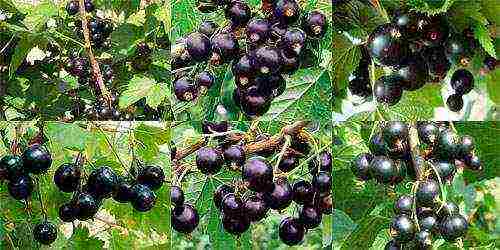
The first impression suggests that all shrubs of black currant species are similar. But this is only the first impression. In fact, a huge number of varieties are known, and breeders continue to breed new varieties. The main way to cross is selected large-berry varieties, this helps to grow bountiful yields that are easy to harvest.
But the success of the harvest depends not only on this. The gardener's actions should be distinguished by the absence of errors in them. The choice of varieties must be correct, the placement of bushes on the site must meet the requirements, care must be organized as necessary. If the conditions are met, the currant will gratefully respond to the care shown with an excellent harvest.
Early
A large number of varieties of black currant are known, ripening early. The following are considered promising:
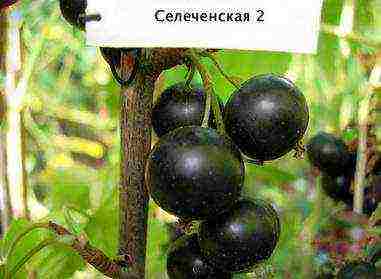
- Selechinskaya 2 - the variety differs significantly from the usual currant berries, combining the best differences between wild currants and gooseberries. Its bushes tolerate the dry period without any problems. The berries of this early variety are distinguished by their versatility, their yields are enviably high and amount to four to five kilograms from each bush. The size of the berries is large, rounded in shape. The color is black, shiny. The mass of one is from three to five and a half grams, the taste is amazing. Each hundred grams of the product contains 161 mg of vitamin C. This variety is capable of developing well in any region of Russia. Berry bushes are distinguished by strong straight branches, they do not need tying.

- A summer resident is more suitable for the European regions of Russia than others. This type of currant is distinguished by high yield indicators, large-sized berries (from two to three and a half grams), and short ripening periods. The bushes are so stunted that with bountiful harvests, the branches adhere to the surface of the earth. The berries have good taste, without the characteristic sourness. Their ripening is uneven, which makes it possible to harvest for a long period. The cultivar is known for its resistance to powdery mildew and anthracnose, as well as rust and kidney mites.
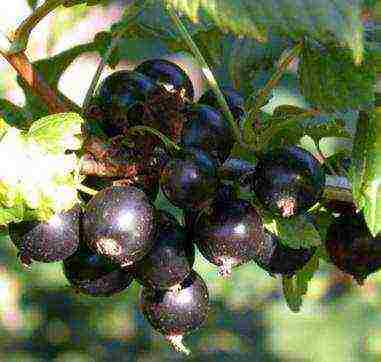
- Exotic - refers to varieties with large berries, fully ripens in the middle lane. The cultivar was developed by crossing Blueberry Seedling and Bradthorpe. The berry weighs up to three grams, their taste is sour-sweet, the skin is shiny. Berries, when separated from the branches, remain dry, collected easily and quickly, and can be stored in the refrigerator for several days. The bush gives a high yield, is characterized by medium growth and straight branches, not too thickened. The foliage is large, the axis of the berry brush is straight. Up to ten berries are tied on it.It resists powdery mildew, but is affected by anthracnose. The variety tolerates winter cold well. The yield is not very high - one bush gives up to a kilogram of berries, which differ in manufacturability.

- Maria Kievskaya - gives stable yields of medium volumes. The bushes are resistant to columnar rust and powdery mildew. Their forms are of medium height and slight spreading. Berries weigh up to four grams, sweet and sour, used for processing or freezing.
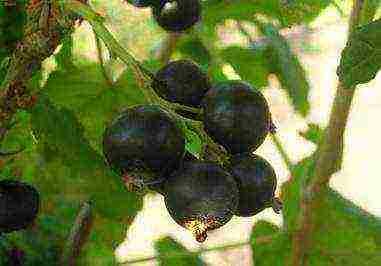
- Nestor Kozin is another early variety. The berries are quite large (from three to four grams), sweet in taste. Compact bushes reach one and a half meters. This variety produces good yields from the second season of development. The plant perfectly resists anthracnose and powdery mildew, perfectly tolerates frosty winters and dry seasons.
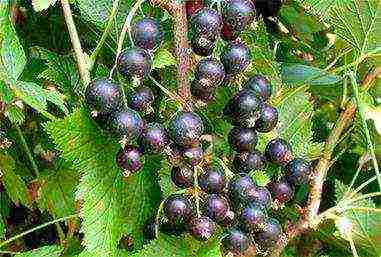
- Perun - this variety has a pleasant aroma, it is considered a dessert. The berries weigh about two grams and contain a large amount of sugar. Medium-sized crops, up to one and a half kilograms per bush. The plant perfectly tolerates return frosts, does not suffer from dry seasons. The main disadvantage of this species is that it is considered overly susceptible to powdery mildew.
Average
Gardeners prefer to grow these varieties because of the large size of the berries and the timing of their ripening:

- Dubrovskaya - perfectly tolerates the winter season, resists kidney mites and anthracnose, does not lend itself to terry. The yield reaches three kilograms from each bush, which is distinguished by its low growth and compact size. The berries are medium in size.

- Dobrynya - perfectly tolerates the dry period and spring frosts. Does not lend itself to powdery mildew, well resists anthracnose and mites. The bush is weak and erect, but differs in large berries, yields up to two and a half kilograms.
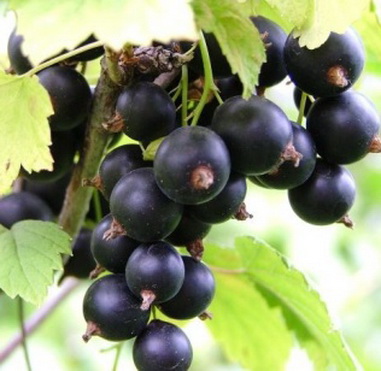
- Raisin is a dessert variety with an average ripening period. Berries of different sizes, from medium to large, their average weight is about three grams, their aroma is refreshing, in one hundred grams of the product the content of vitamin C reaches one hundred and seventy grams. The plant has a high yield, resists powdery mildew, spring frost and winter cold. Berries are considered one of the sweetest among the other varieties of currants. They do not wither on the branches, do not crumble when ripe.
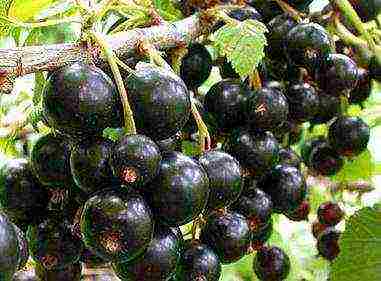
- Yadrenaya is another representative of medium-ripening varieties. The berries are one-dimensional, rather large (about five grams), plum-shaped. The taste is somewhat refreshing, sourish. The yield is high, reaching twelve tons per hectare. Bushes perfectly tolerate frost, resist various pests, powdery mildew and rust. The main disadvantage is the very rapid aging of the bushes, which occurs due to a decrease in the growth of young shoots. The variety is more suitable for Western Siberia. Growing it in the middle lane entails a decrease in yield and size of berries.
Late
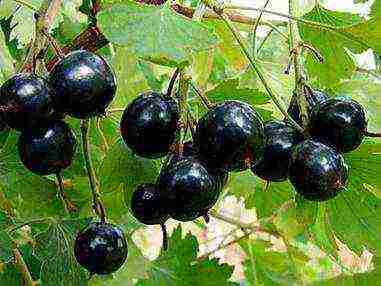
- Venus - the weight of the berries reaches six grams, the skin is thin. The taste is excellent. The berry is sweet, suitable for fresh consumption and for processing. The productivity of the variety is high, and its resistance to the winter period is good. The variety perfectly tolerates powdery mildew, resists harmful parasites, does not die in the dry season. Bushes of medium height, strong and spreading. Fruiting occurs early.
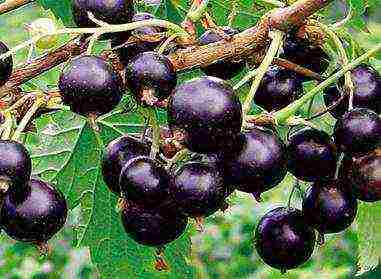
- Vologda is a vigorous currant bush that winters well, resists powdery mildew and bud mites, but is susceptible to rust. The yield of large-sized berries is about four kilograms per bush, their ripening is uneven.

- Katyusha - hibernates without problems, resistant to anthracnose and powdery mildew, susceptible to kidney mites. The bush is tall, the spreading is weak. The berries are large in shape, their skin is dense.
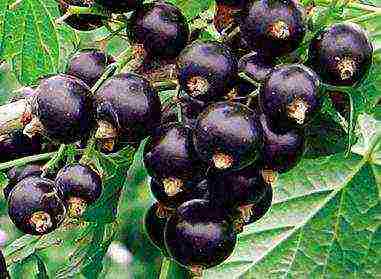
- Mermaid - begins to bear fruit early, perfectly tolerates winter cold. The yield reaches three and a half kilograms.A vigorous bush has medium spreading and large berries. The plant resists powdery mildew and kidney mites, septoria and anthracnose.

- Bagheera - average yields of this variety reach twelve tons of berries per hectare of medium size, sweet and sour taste. The variety perfectly tolerates winter cold, does not lend itself to powdery mildew and kidney mites. The main difference between Bagira berries is their excellent transportability and the ability to use mechanized technologies during cultivation.
Features of different varieties
- Varieties with berries that have a dessert flavor are recommended for eating. If the skin is thin, then the berries are better for rubbing with sugar. Thicker-skinned people tolerate freezing well, retaining their qualities.
- If you have problems with watering, opt for breeding drought-resistant varieties. The types of currants are divided according to the content of vitamin C in berries, the resistance of plants to recurrent spring frosts. It is very important to take into account the unpretentiousness of the plants - resistance to winter cold, diseases and pests.
- The individual conditions of each site, the climate and the organization of care can affect the taste of berries, yield and other parameters.
- The results of long-term observations of the studied varieties have proved that almost all of them are able to withstand winter conditions. Occasionally freezing of shoots can be observed in the most severe cold weather.
- As a rule, black currants begin their growing season from mid-April or early May. From its beginning to the onset of flowering, it takes from two weeks to one month.
The plant blooms from the second half of May. At the same time, the earlier varieties bloom several days faster than the middle and late ones. The flowering period lasts three to four weeks.
Black currant bears fruit on mixed shoots, the annual growth of which is up to twenty-five centimeters. One of the main indicators of the value of the variety is the weight of the berries, their sweetness and aroma.
Plant care
- Black currant loves lighted areas, but can grow in shaded areas. It is recommended to place plantings along the southwest walls of buildings.
- The plant is hygrophilous. For this reason, watering is recommended during the dry season in early June, July and mid-August. Irrigation method - sprinkling.
- Black currant bushes do not tolerate excessively humid places. Groundwater should be no closer than one and a half meters from currant roots. In the third year of growth, it is recommended to apply organic fertilizers in the form of humus or compost under each bush. Their rate is half a bucket per bush. For the same purpose, superphosphates and potassium sulfate are used. Nitrogen-containing substances are used annually. Eighty grams of saltpeter is applied under the bush.
The root system of the currant is located close to the surface of the earth, so we recommend loosening it with great care. - Currants are planted until the buds bloom, with the beginning of spring. But the autumn period is better for this procedure. Landing is carried out according to the scheme of two meters by one and a half. Reproduction of currants is carried out by cuttings and layering. For planting, they are prepared in half a meter in size, it is recommended to bury the seedling ten centimeters, maintaining a slight slope. Planting ends by cutting off the shoots to the second or third bud.
- During the growth period, the bush should consist of fifteen to twenty branches, differing in different ages. Cutting currant bushes is recommended in early spring, before the buds begin to bloom. The same procedure is performed in the fall, after the fall of the foliage is completed. In this case, thinning of the bushes is carried out by removing five-year-old branches, which are characterized by weak growth.
Useful qualities of berries
- They are considered beneficial to the body.The berries are used in folk medicine as a therapeutic and prophylactic purposes.
Blackcurrant prevents cancerous disease, a beneficial effect on the cardiovascular system. - Elderly people use currants berries recommended for the purpose of preventing the weakening of mental abilities.
- currants prevent the manifestation of diabetes. For this purpose they are administered in the diet, and to enhance recovery of the body during various diseases.
- Currant fruits help in the treatment of kidney stones, liver and respiratory system. Content of vitamin C is an important factor for the full zheznedeyatelnosti body.
Blackcurrant belongs to the useful plants. Berry bushes are easy to grow. It remains only to choose varieties that will feel great in the garden area. Useful properties of this surprising berries stored therein with all known methods of processing and storage conditions.
Currant gooseberry from the family was "tamed" the man relatively recently - only about 500 years ago, when the time of cultivation of pears and apples thousands of years. By the way, the Moscow River had once styled Smorodinovkoy due to growth along the shores of these shrubs. Today, the "young" culture can be seen in any garden site.
Breeders constantly offering us new hybrids in view of the maturation periods for different climate zones. When breeding them is also paid attention to the size and taste of the fruit, the length of the brush, forming the bushes, their resistance to cold and disease.
Important criteria to achieve the "ideal" currants are also its vitality samoplodnye, productivity. At the same time guided by the manual collection of domestic experience crop for use in fresh and frozen forms for blanks (jam, jam, drinks and so on. N.)
A foreign selection is designed mainly for the mechanized collection of raw materials without regard to their size, weight for industrial processing.
About the features of black currant
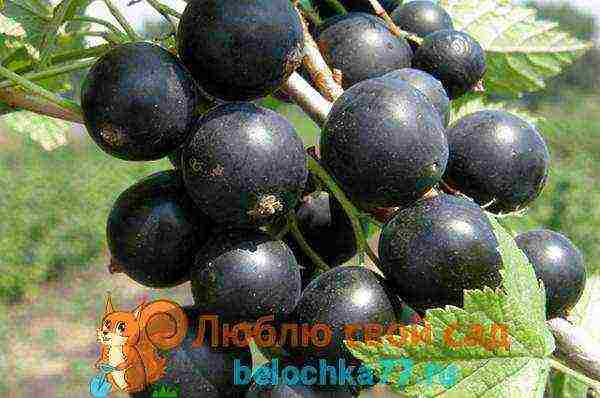
The popularity of black fruits is explained by its several advantages over red and white, namely:
- higher saturation of all aerial parts with essential oils. They are contained in special glands densely located on the underside of the leaves. Therefore, the whole plant has a pronounced aroma, extraordinary aroma.
- the content of ascorbic acid prevails here several times more than in fruits-"congeners" of a different color. By the way, even green berries have 4 times more nutrients than fully ripe ones. Isn't that why our children love the ripe currant so much? ...
- the fruits are less acidic and less watery than other fruits of these plants. Therefore, the volume of juice prepared from them will be about 10% lower than from lighter berries.
- high frost resistance, which is very important for the cold regions of our country
- the possibility of reproduction not only by bushes, but also by cuttings, layering.
Blackcurrant also has a high demand for soil moisture, vulnerability to various diseases, pest damage. At the same time, it requires constant formation, competent thinning of branches of different ages.
Many of these varieties can bear fruit for up to 30 years with proper care (choosing the right soil and planting site, pruning, watering, loosening, fertilizing, etc.).
Ripening classification

Climate features, soil properties in different places affect the development and fruiting of the bush, This is of decisive importance when choosing seedlings. After all, only 50 of the more than 200 available varieties can be successfully grown in different regions of the central, middle zone of Russia.
One of the important criteria for choosing gardeners is, first of all, the ripening time, namely:
- Early... Their flowering begins in the first half of May and ripe berries appear by mid-June. These include Dachnitsa, Dikovinka, Dubrovskaya, Heiress Pygmy, Rusalka, Selechinskaya-2, Black Boomer, Exotic, Spherical, etc.
- Medium varieties bloom from mid-May, and ripen by the end of July. These are: Bagira, Belorusskaya Sweet, Vologda, Dobrynya, Daughter, Zhuravushka, Izyumnaya, Katyusha, Rusalka, Sadko, Selechinskaya, Black Pearl and a number of others.
- Mid-late ripening in the second decade of July reaches Bagheera, Barrikadnaya, Venus, Vologda, Pearl, Green Haze, Emerald Necklace, Titania, Yubileynaya Digging, Orlov waltz and a number of other varieties. They are most often chosen by gardeners, summer residents. Indeed, thanks to the warm, sunny weather, the berries accumulate the maximum amount of nutrients and vitamins.
- Late the varieties are perhaps the smallest group here. They bloom from the second half of May, and the berries ripen in the first decade of August. Due to the very long growing season, they are most exposed to damage by pests and fungi. The most popular are such varieties as: Arcadia, Altai late, Lazy, Mila, Tatyanin's day, Yadrenaya.
When choosing any of these options, it is important to remember that all berries have the same composition of trace elements, vitamins, and excellent therapeutic and prophylactic properties. Seasonal factors influence their specific gravity, glucose level, degree of sweetness or acidity of currants.
Note! The soil conditions of the growing places of varieties, the weather of a particular year / month can also affect these indicators.
We take into account the criterion of "self-fertility"
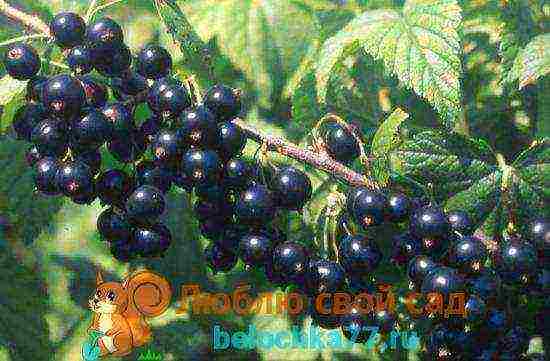
The specificity of currants is that most of its varieties are capable of pollination with their own pollen, that is, they are self-fertile. This is reflected in the number of their ovaries, the formation of fruits in comparison with plants with free pollination.
Among the varieties with 50% self-pollination are large-fruited Azhurnaya, Dachnitsa, Temptation, Pigmey, Nara, Sevchanka and many others. Binar, Golubichka, Dar Smolyaninova, Debryansk, Temptation, Selechinskaya-2, Sudarushka, Tamerlan, Yadrenaya, etc. have a good indicator (from 30 to 50% of self-fertility).
Therefore, to increase the yield of large berries, it is recommended to plant several bushes from different varieties nearby.
The best varieties for the Moscow region
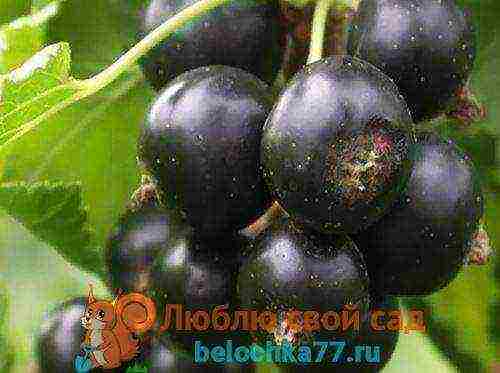
When choosing currant seedlings for central Russia with low winter temperatures, it is important to take into account the structure of its infertile, acidic soil.
And the achievement of a positive effect suggests that when planting it must be "ennobled" with fertilizer, liming, etc. This increases the fertility of the soil, allows you to achieve the required degree of neutral or slightly acidic reaction (pH from 5.0 to 5.5).
- Based on practice, many gardeners consider the best early varieties for the climatic conditions of the Moscow region such as Dachnitsa, Zhemchuzhina, Izyumnaya, Nara, Nester Kozin, Pigmey, Selechinskaya, Black Boomer, Exotic. The fruitful, self-fertile, winter-hardy Moscow region also feels good.
- Among the varieties with average terms ripening are worthy of attention Belorusskaya sweet, Detskoselskaya, Dobrynya, Dubrovskaya, Izmailovskaya, Katyusha and others.
- Ideally suited for the climate near Moscow, such late varietieslike: Bummer, Vologda, Daughter. It is characteristic that they painlessly tolerate low winter temperatures and remain resistant to pests and diseases.
A characteristic feature of these options is that they are adapted to the specifics of the region's climate: drought resistance, spring sharp drops in air temperature.
Choosing currant varieties for the Urals
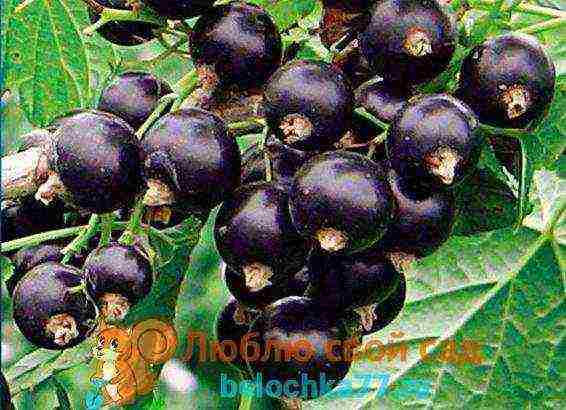
Climatic conditions in all regions of the Urals are much more severe than in the central part of Russia. In winter, here the average temperature with strong winds can reach from -20 ° C to -40 ° C, and in summer - up to + 35 ° C.
Therefore, when selecting large-fruited black currants, it is recommended to dwell on cultivated seedlings that take into account such features. In order to avoid massive damage to ovaries and flowers during spring frosts, varieties with different periods of their flowering should be planted.
We offer you to get acquainted with the most hardy plants that can develop and bear fruit even in rather cool regions. Here you can focus on the proposals of zoned varieties from breeders from Sverdlovsk and other specialists.
- Among the early varieties of flowering and ripening of berries, we advise you to pay attention to the Ural Chant, Dobry Djinn, Sibylla. Along with this list, the "old" assortment is also worthy of attention, namely: Gross, Pygmy, Pamyat Michurin, Gift to Kuzior, Spherical.
- An intermediate option can be one of the best varieties of recent years with early and medium ripening Pilot.
- Mid-late varieties are represented by Fortuna, Globus, Dashkovskaya, Venera, Sudarushka bred in this region, as well as by Siberian breeders - Prestige.
- Of the late species, Bagira, the local Slavyanka, the Siberian Yadrenaya, and the Ukrainian Krasa Lvova have proven themselves well.
In each of these categories, large-fruited black currant has winter hardiness, adaptation to sudden temperature changes, recurrent frosts.
The best currant for Siberia

On the immense Siberian expanses with its climate and soils, local and European breeding with different ripening periods can take root well. Naturally, seedlings with increased frost resistance of the Far Eastern, Altai, and Ural selections take a worthy place.
They were bred specifically for the Northern, Northwestern, Far Eastern regions. However, the latter develop somewhat more slowly at first and begin to grow normally, like their counterparts from Europe, only in the second year after planting.
The best large-fruited varieties here are considered to be highly resistant to hard frosts, unpretentious growing conditions.
- Those who wish to plant currant bushes with early maturation large berries can be used by seedlings of Raisin, Selechinskaya, Sibylla.
- Among varieties of the middle period ripening of large-fruited black currants have shown themselves well: Brown Far East (another name is Brown Favorskoy), Hercules, Globus, Lucia, Yadrenaya.
- Adapted to Siberian growing conditions late ripening large, sweet healthy berries. These include the following varieties: Altai late, Arcadia, Bagheera, Venus, Lazy, Mila, Perun, Tatyana's day.
- Admirers super large black berries with their even distribution throughout the brush, seedlings with different ripening periods are chosen. Among them are Globus, Dobrynya, Large-fruited Litvinova, Romance, Pygmy, Selechinskaya, Sibylla, Yadrenaya. It is characteristic that the roots of bushes and cuttings remained undamaged even in May frosts down to -10 ° C.
- For those who, among all indicators, prefer abundance of harvest We recommend Gross, Summer Resident, Druzhnaya, Izyumnaya, Lazy, Ussuri, Yadrenaya. And the most resistant to diseases, pests are considered such varieties as: Globus, Gulliver, Valovaya, Sevchanka, Sibilla.
"Hits" of varieties of large-fruited black currant:
Vigorous
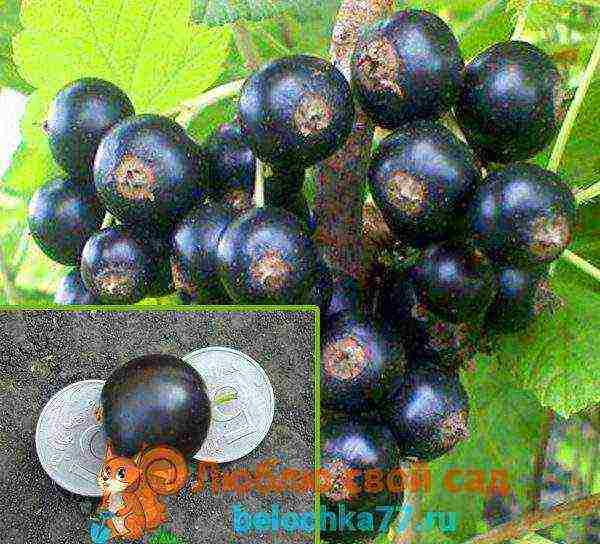
Bred by Siberian breeders and recognized as one of the world leaders among mid-ripening varieties of berries. Spreading bushes, low-growing, medium thickened. Its plum fruits with a diameter of up to 3 cm weigh more than 6 g, have a refreshing taste, reaching up to 8 pieces on a long cluster.
They have a firm pulp with a sour taste with a refreshing aroma. Able to give a high yield of up to 12 tons per hectare. The bush needs systematic rejuvenation. Has a relative resistance to disease.
Black Pearl
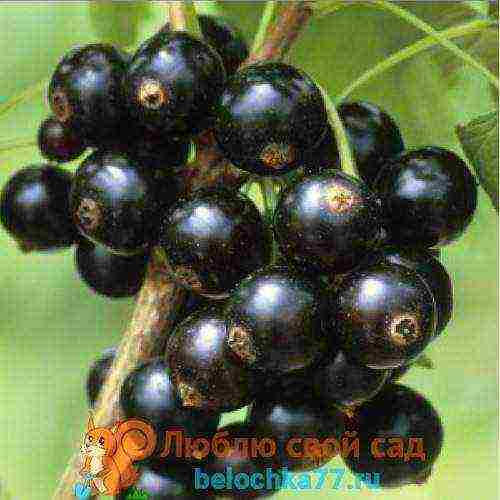
It is characterized by a sprawling bush of medium height and sparsely growing leaves.Rounded black berries with a hard skin weighing up to one and a half grams with a "pearl" shine reach a diameter of 7 cm.
It is characterized by high winter hardiness, early maturity, productivity, moderate resistance to diseases.
This large-fruited variety is distinguished by stable fruiting, a high level of healing vitamins C and pectin. Well suited for manual and mechanized harvesting in mid-July.
Titania
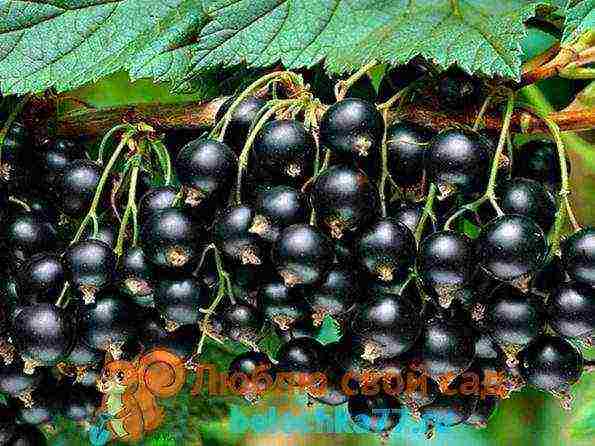 Currant Titania (Titania)
Currant Titania (Titania)
Which is also called the Swedish queen with Russian roots. After all, the variety was bred in Sweden by crossing the Altai dessert with Kajaanin Musta-Tamas (Musta Tamas).
It has a high bush up to 1.5 m, from which you can collect up to 5 kg of large berries. The weight of each sweet and sour dense fruit from 20 on one brush reaches up to two grams. You can feel their dessert taste and wine aroma already at the beginning of July.
The advantages of Titania include its adaptation to the coldest climate, resistance to disease and bad weather, a rich harvest without complicated agricultural technology. Thanks to these properties, the variety is used as a base for further breeding. For example, in Poland, it is used to display Tisel.
Selechenskaya 2
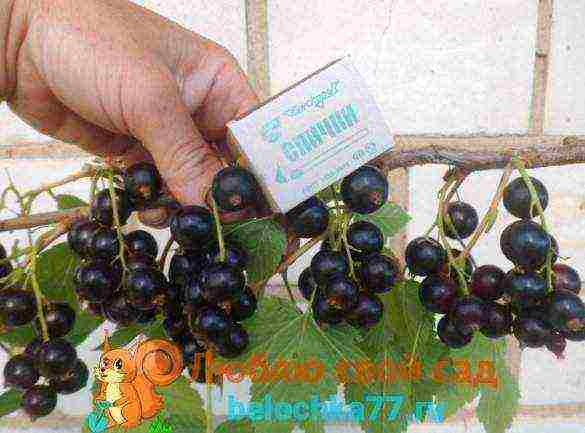
Takes a worthy place among early ripening varieties. The bush is slightly spreading, medium-sized, rather thickened. Very large, rounded, medium-dense berries weigh up to 2.5 g and contain a lot of sugar and ascorbic acid.
This high-yielding variety is cold-resistant, but not afraid of hot seasons. Belongs to plants that need intensive care, fertile soil.
Selechinskaya is resistant to damage by powdery mildew, but to a lesser extent - by harmful insects.
Pygmy
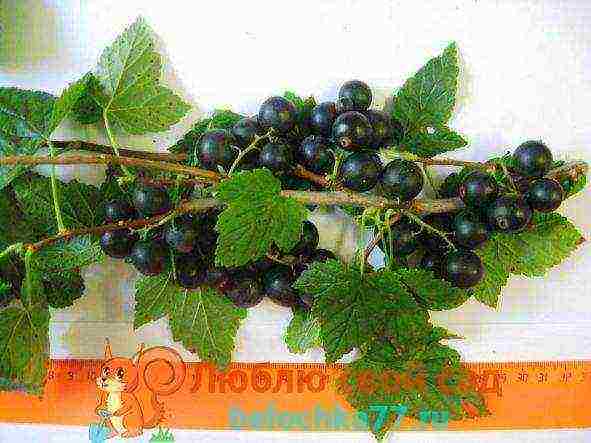
Dessert variety of Ukrainian selection with a mid-late ripening period. Its long clusters up to 11 cm can hold more than 20 berries. Pygmy is considered a favorite of summer residents for the attractive taste of aromatic, sweet fruits.
Very large, round berries have few seeds in the pulp. These slightly sprawling bushes with thick and strong stems painlessly survive severe winter frosts and sultry summers.
Differs in high productivity, self-fertility, resistance to anthracnose and powdery mildew. Growing problems with this variety include some susceptibility to disease (septoria) and kidney mite damage.
Dobrynya

It is a medium-ripening variety with super-large berries. The medium-sized, upright bush is compact and is capable of generously bearing fruit up to 3 kg. Oval, black with a shine, fruits with elastic dense skin have a fragrant sweet and sour taste.
Characterized by high winter hardiness, average resistance to spring frosts and aridity, early maturity, sufficient yield. In summer and spring, it needs intensive care.
Dobrynya is not subject to powdery mildew diseases, but it can be damaged by other fungal diseases and pests.
Raisin

It is one of the leaders in dessert varieties with early ripening of large berries. On a straight bush, up to 1.5 m high, large, round fruits grow matte black fruits with a sweet taste. And at the end of July, after reaching full ripeness, they do not crumble, and when wilted, they resemble raisins. Thanks to these exclusive qualities, it got its name.
This variety is winter-hardy, tolerates drought well, abrupt changes in the external environment. It is characterized by resistance to fungal diseases, kidney mites, and ash. The disadvantages include poor rooting by cuttings.
Lazy person
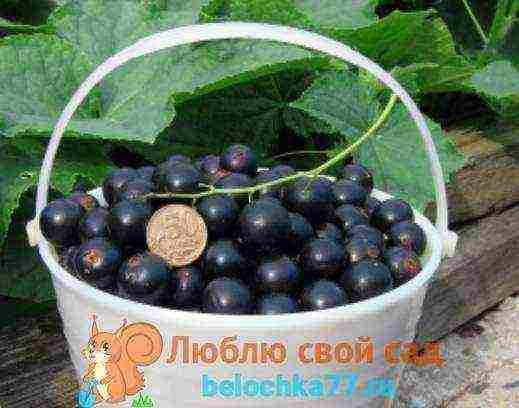
Belongs to the varieties of the latest ripening dates only by the beginning of August. They ripen as the last hello of summer, when the bulk of the plants cease to bear fruit, which is reflected in its name. However, long expectations of the harvest are fully justified.
Strong, tall, spreading bushes with thick leaves grow very large sweet berries.They have a round shape, black-brownish color, pronounced taste and aroma of medium density pulp.
It also attracts with its high frost resistance, the ability to withstand various diseases, damage by pests. These are septoria, anthracnose, terry, columnar rust. However, it has little resistance to powdery mildew.
Problems include also uncomfortable ripening of fruits, instability of yield.
Black BMW

Ukrainian selection pleases with its shiny super-large berries, ripening already in early June, weighing up to 7 g. They ripen evenly, have a one-dimensional shape, sufficient pulp density, exquisite aroma, and a high level of sweetness.
Clusters with fruits that do not fall off after full ripening on the stalks of powerful branches outwardly resemble bunches of grapes. This unique variety is very fond of children, because it is one of the very first summer sweet berries.
In terms of yield, Black Boomer can compete with many varieties of currants and is very undemanding to care, resistant to diseases. According to many gardeners, these qualities have gained fame not only as a magnificent variety, but also became a new era in the development of such a culture.
Constellation
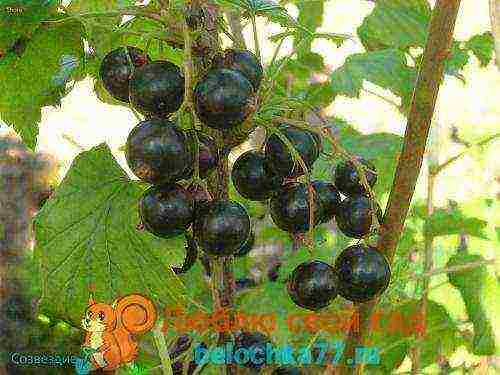
Belongs to varieties that ripen quite early. Here currant bushes are medium-sized, slightly spreading with straight, not very thick branches. Rounded berries of uniform size reach a weight of up to 1.5 g, have a sweet and sour taste.
A feature of the variety is the ability to bear fruit without abundant watering and even without it. Already in the second season of its growth on a young bush, you can collect about 1 kg of berries, and then up to 3 kg, even in the driest times.
In the constellation of its merits, along with the early periods of simultaneous ripening, the size and quality of the fruits, others can be named. This is a good resistance to diseases and pests, high self-fertility and winter hardiness. Vulnerability - poor resistance to kidney mites.
Gulliver

Belongs to early varieties and requires good light and high soil moisture. It has tall trunks with curved, thick olive-greenish shoots with densely growing leaves. Hence, their exactingness to maintain a large distance between neighboring plants (from 1.5 to 3 m).
With proper planting and proper care, one bush can produce more than 3 kg of very large round-shaped berries weighing more than 3 g each. Shiny fruits with medium-density pulp have an excellent taste with a slight sourness, which many gardeners like. From the time of flowering to full ripening of currants, it takes up to 70 days.
Gulliver is resistant to severe winter cold and spring frosts, diseases and kidney mites.
Summer resident
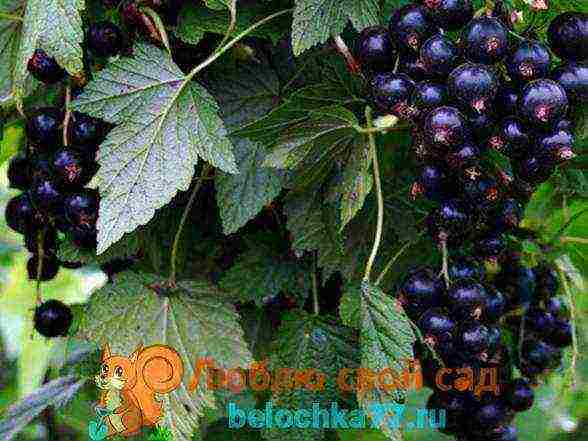
"The brainchild" of Dutch and Russian breeders. When developing the variety, emphasis is placed on its ability to withstand over -35 ° C. They managed to achieve high yields of several undersized, sweeping bushes.
Very large sweet berries of the Summer resident with good taste, with abundant ripening in early July, can bend the branches to the ground. To avoid this, it is advisable to use the props in a timely manner. It is characteristic that when ripe, the berries crumble. Due to the uneven ripening of the fruits, the harvest time can be extended. The variety is also interesting for its increased resistance to infections, tick attacks, sharp temperature fluctuations.
Bagheera
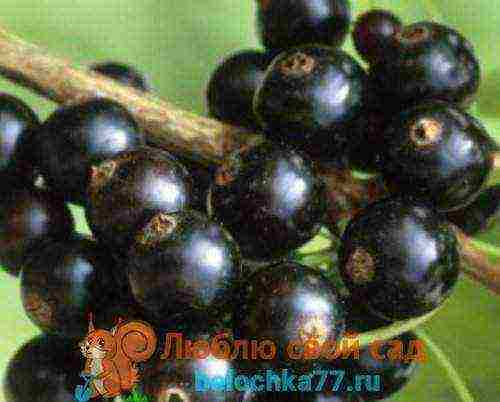
With an average maturity of berries, it has spreading bushes with a height of up to two meters. Bagheera enters the season of abundant fruiting already in the second year after planting. This is one of the few fruit shrubs that do not begin to shed their leaves with the onset of winter.
Rounded large fruits weighing up to 3 g, attractive glossy black color have a juicy, tender pulp, covered with a dense skin. Up to 7 pieces of sweet aromatic berries are collected in nodes on 2-3 brushes, forming a massive and rather picturesque bunch.The presence of a sufficient number of them allows you to collect up to five kg from one bush. The variety is adapted to cold and heat, has an average resistance to pests.
Big Ben
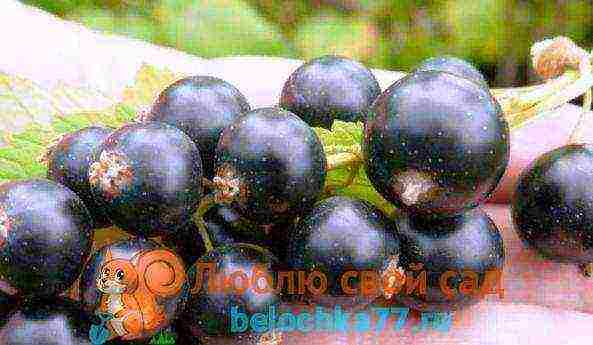
Originally from Scotland and belongs to the mid-early varieties with rather large berries ripening together, weighing about 4 g. The fruits have an excellent dessert taste with a predominance of sweet notes over sour ones. Even when fully ripe, they remain on the branches and retain their aroma and taste.
Only in extreme heat can such berries look like withered. Fruiting begins at a trunk height of 15-20 cm and ends at the top of a vertically directed bush.
Achievement of high yields is possible in the second year after planting more than 5 kg, and in the third - over 10 kg.
The main condition for care is competent pruning, fertilizing the soil when planting and developing a bush, watering and other subtleties of intensive agricultural technology. The variety is very frost-resistant and can resist powdery mildew.
Gross
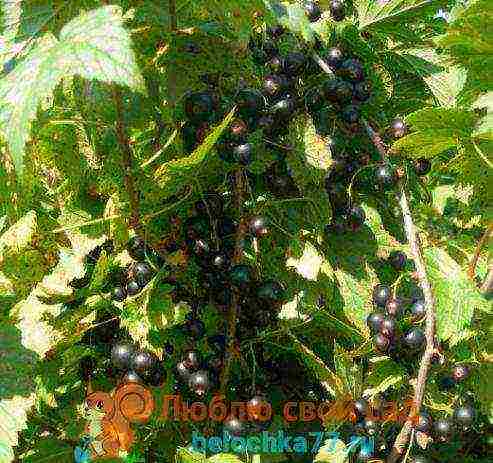
With medium-early ripening of large fruits. The variety has highly spreading bushes and a moderate density of several wrinkled convex leaves. Rounded berries of sweet and sour taste with a maximum weight of about 2.5 g form clusters up to 10 cm long on the petioles. The uniformity of fruits with a small number of seeds is one of the advantages of Gross. Has an average yield of about 4 kg per bush.
This self-fertile variety tolerates winter cold well, it is quite resistant to various diseases and pest damage. The variety is intended for universal use, both fresh and cooked.
We hope that our article will help you choose your "format" of large-fruited black currant! Experience the satisfaction of your diligence, get pleasure, benefit for your soul and body!
On any summer cottage in different regions of Russia, black currant bushes grow. The plant does not require special care and is resistant to frost, it brings a rich harvest even in subarctic regions. This garden culture is planted in Yakutia and the Khibiny. Black currants are grown by summer residents from Sakhalin in the east to the Krasnodar Territory in the south.
The plant has such a unique ability to adapt to any climatic conditions thanks to its ancestor - the wild currant that grows in the forests. It will not be difficult for an amateur gardener to make a choice and grow currants if he carefully studies the description and looks at the photos presented in the article. Since there are good varieties and types of this culture, there is a huge amount.
The best varieties of black currant and their differences
The varieties differ in the following indicators:
- By appointment;
- The speed of fruit ripening;
- The volume of the harvest;
- Taste of pulp;
- Resistant to low temperatures;
- Resistant to diseases and viruses.
By purpose, the fruits are subdivided:
- Dessert variety - berries with excellent taste;
- For preservation and preparation - fruits with soft and delicate skin, sour taste;
- For freezing - thick-skinned currants;
- Universal varieties.
When choosing a variety, you should pay attention to the region in which it is recommended to grow it. Plants suitable for planting in a particular area produce a good harvest.
Weight, ripening time of the crop, taste may differ depending on the area in which the plant was planted and on the composition of the soil or watering. At a distance of more than 200 km, the main characteristics of the berry can vary greatly.
Summer residents for central Russia are advised to choose the following varieties:
- Early ripening - at the end of June: "Exotic", "Dikovinka", "Selechinskaya", "Dachnitsa", "Orlovia", "Openwork";
- The average ripening period is the second half of July: "Faithfulness", "Green Haze", "Black Pearl", "Zusha", "Perun";
- Late ripening period - from the second half of July to August: "Rusalka", "Venus", "Kipiana", "Yadrenaya".
Large-fruited varieties of black currant
"Vigorous"
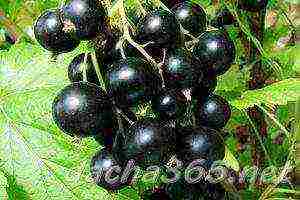 The berries of this variety are the largest, resembling grapes in size. The weight of one unit varies from 3.1 to 8.1 grams. "Vigorous" is distinguished by the mid-late ripening of the crop. The bush is small in size, spherical in shape, in height it can reach 1.1 - 1.6 m. After 5.5 - 7 years, the plant must be replaced, since the fertile age ends. The flesh tastes juicy and sweet, the berries are fleshy, covered with thick skin. Representatives of the species tolerate frost well, and are also not susceptible to the effects of hazelnut and kidney mites. The yield is good, for the season you can collect from 3.1 to 6.1 kg from one bush. currants. The flowering period of "Yadrenaya" begins in the first week of May. Ripe fruits appear at the end of July.
The berries of this variety are the largest, resembling grapes in size. The weight of one unit varies from 3.1 to 8.1 grams. "Vigorous" is distinguished by the mid-late ripening of the crop. The bush is small in size, spherical in shape, in height it can reach 1.1 - 1.6 m. After 5.5 - 7 years, the plant must be replaced, since the fertile age ends. The flesh tastes juicy and sweet, the berries are fleshy, covered with thick skin. Representatives of the species tolerate frost well, and are also not susceptible to the effects of hazelnut and kidney mites. The yield is good, for the season you can collect from 3.1 to 6.1 kg from one bush. currants. The flowering period of "Yadrenaya" begins in the first week of May. Ripe fruits appear at the end of July.
Advantages:
- Large berries;
- It tolerates frost well;
- Self-fertility;
- Productivity.
Minuses:
- Needs careful care;
- Bushes stop bearing fruit after 5-7 years;
- Fruit pulp tastes sour;
- The species is susceptible to the spread of powdery mildew.
Dobrynya
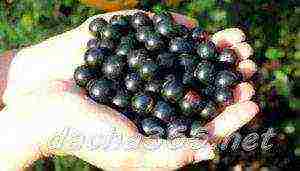 It belongs to a large-fruited variety of black currant, has an average ripening period. The weight of the berry is 3-7 g, the size of the fruits is not uniform, different. The pulp has a sweet and sour taste, the skin is hard. In 100 gr. berries 200 mg of vitamin C, sugar content - 6.9%.
It belongs to a large-fruited variety of black currant, has an average ripening period. The weight of the berry is 3-7 g, the size of the fruits is not uniform, different. The pulp has a sweet and sour taste, the skin is hard. In 100 gr. berries 200 mg of vitamin C, sugar content - 6.9%.
The plant is of medium size, the height of the bush is from 1.1 to 1.6 m. "Dobrynya" tolerates frost and drought well, and is resistant to the spread of powdery mildew. One shoot per season can be harvested from 1.7 to 2.5 kg. The flowering period begins in mid-May. The first crop is harvested in the second half of July.
Advantages:
- Large and tasty fruits;
- Medium-sized plant;
- It tolerates frost and drought well;
- Not susceptible to the spread of powdery mildew.
Minuses:
- Average yield;
- Irregularity of berries;
- Susceptible to kidney mites and anthracnose.
"Selechenskaya - 2"
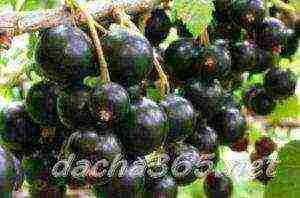 Berries of this type are large and tasty, and are considered the most delicious. The weight of one fruit is up to 6 grams. The pulp is sweet, with sourness. Vitamin C content per 100 gr. - 160mg, sugar - 7.4%. Ripens early, in early July, and the flowering period begins in the first half of May. The height of the bush is from 1.6 to 1.8 m. Selechenskaya is resistant to frost and the spread of powdery mildew. During the season, the plant produces a yield of 2.6 to 5 kg.
Berries of this type are large and tasty, and are considered the most delicious. The weight of one fruit is up to 6 grams. The pulp is sweet, with sourness. Vitamin C content per 100 gr. - 160mg, sugar - 7.4%. Ripens early, in early July, and the flowering period begins in the first half of May. The height of the bush is from 1.6 to 1.8 m. Selechenskaya is resistant to frost and the spread of powdery mildew. During the season, the plant produces a yield of 2.6 to 5 kg.
Advantages:
- Big and tasty berries;
- It tolerates low temperatures well;
- The species is not susceptible to the appearance of powdery mildew;
- Productivity.
Flaws:
- The plant can become a victim of diseases: anthracnose, kidney mite.
Sweet varieties of black currant
"Green Haze"
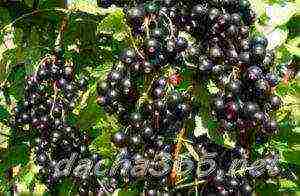 Representatives of the species have an average ripening period. The plant bears fruit only one year after planting. The bush is not very tall, medium spreading. Currants have a pleasant aroma, one berry weighs from 1.6 to 2.6 grams. 10 grams of pulp contains 193 mg. vitamin C, and sugar - 12.3%. "Green Haze" tolerates low temperatures well and does not get sick with powdery mildew. One shoot per season can be harvested from 4.1 to 5 kg. The plant begins to bloom in the second half of May. A ripe crop can be harvested in the middle of summer.
Representatives of the species have an average ripening period. The plant bears fruit only one year after planting. The bush is not very tall, medium spreading. Currants have a pleasant aroma, one berry weighs from 1.6 to 2.6 grams. 10 grams of pulp contains 193 mg. vitamin C, and sugar - 12.3%. "Green Haze" tolerates low temperatures well and does not get sick with powdery mildew. One shoot per season can be harvested from 4.1 to 5 kg. The plant begins to bloom in the second half of May. A ripe crop can be harvested in the middle of summer.
Advantages:
- Delicious and sweet berry;
- Productivity;
- Frost resistance;
- Refers to early-growing species.
Minuses:
- May be severely affected by exposure to kidney mites.
"Nina"
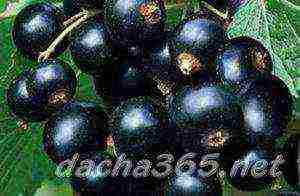 "Nina" refers to early ripening varieties. The plant has many shoots, medium size, bushes are densely arranged. The berries are large, from 1 to 1.35 cm in diameter, the weight of one piece is from 2 to 4 grams. 100 grams of pulp contains 180 - 269 mg of ascorbic acid. Currants ripen almost simultaneously, the yield is good. "Nina" tolerates the cold season well. The variety has an average resistance to powdery mildew disease. From one bush you can collect from 3 to 4 kg per season, if you do not forget to feed and water the soil, then the plant yields up to 8 kg. The flowering period of black currant begins in the first half of May.Ripe berries can be picked in early July.
"Nina" refers to early ripening varieties. The plant has many shoots, medium size, bushes are densely arranged. The berries are large, from 1 to 1.35 cm in diameter, the weight of one piece is from 2 to 4 grams. 100 grams of pulp contains 180 - 269 mg of ascorbic acid. Currants ripen almost simultaneously, the yield is good. "Nina" tolerates the cold season well. The variety has an average resistance to powdery mildew disease. From one bush you can collect from 3 to 4 kg per season, if you do not forget to feed and water the soil, then the plant yields up to 8 kg. The flowering period of black currant begins in the first half of May.Ripe berries can be picked in early July.
Advantages:
- Pleasant taste;
- Ripen at the same time;
- It tolerates frost well;
- Excellent yield.
Flaws:
- Poorly tolerates transportation;
- The species is susceptible to the spread of terry and kidney mites.
"Bagheera"
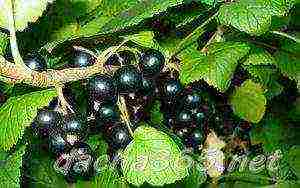 Belongs to sweet varieties, has an average ripening period. The plant is of medium size, from 1 to 1.6 m high. Fruits are large, the weight of one is from 1 to 2.2 g, reach maturity almost simultaneously, keep well on the branch. 100 g of pulp contains 156 - 189 mg of ascorbic acid, sugar - from 9.1 to 11.9%. Ripe berries appear one year after planting. Bagheera tolerates low temperatures and drought, has an average resistance to viruses and diseases. From one shoot, you can collect from 3 to 4.4 kg of currants. The flowering period begins in the second half of May. A ripe crop can be harvested in the middle of summer.
Belongs to sweet varieties, has an average ripening period. The plant is of medium size, from 1 to 1.6 m high. Fruits are large, the weight of one is from 1 to 2.2 g, reach maturity almost simultaneously, keep well on the branch. 100 g of pulp contains 156 - 189 mg of ascorbic acid, sugar - from 9.1 to 11.9%. Ripe berries appear one year after planting. Bagheera tolerates low temperatures and drought, has an average resistance to viruses and diseases. From one shoot, you can collect from 3 to 4.4 kg of currants. The flowering period begins in the second half of May. A ripe crop can be harvested in the middle of summer.
The advantages of the variety:
- Drought and frost resistance;
- Pleasant taste;
- Simultaneous maturation;
- They tolerate transportation well;
Flaws:
- Average degree of resistance to anthracnose, kidney mites, powdery mildew.
Early varieties of black currant
"Exotic"
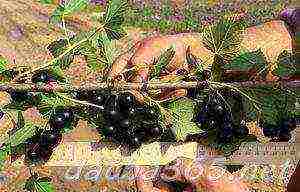 Ripens early. Medium-sized plant, erect, height from 1 to 1.6 m. Fruits are large, taste sweet and sour, with delicate skin. 100 g of pulp contains 8.9% sugar and 199 mg of vitamin C. "Exotic" refers to self-fertile varieties. The species is resistant to columnar rust and powdery mildew, tolerates low temperatures well. Suitable for growing in many regions, including the Moscow region. From one bush per season, you can collect from 1 to 1.6 kg of black currant. The weight of one berry is from 2.6 to 3.6 grams. The flowering period begins in May. Ripe fruits appear in the first half of July.
Ripens early. Medium-sized plant, erect, height from 1 to 1.6 m. Fruits are large, taste sweet and sour, with delicate skin. 100 g of pulp contains 8.9% sugar and 199 mg of vitamin C. "Exotic" refers to self-fertile varieties. The species is resistant to columnar rust and powdery mildew, tolerates low temperatures well. Suitable for growing in many regions, including the Moscow region. From one bush per season, you can collect from 1 to 1.6 kg of black currant. The weight of one berry is from 2.6 to 3.6 grams. The flowering period begins in May. Ripe fruits appear in the first half of July.
Advantages:
- The largest of the early varieties;
- Low temperature resistance;
- "Exotic" is not susceptible to the spread of powdery mildew.
Minuses:
- The plant can be affected by terry, anthracnose and kidney mites.
"Raisin"
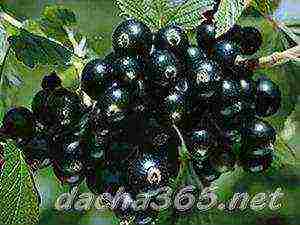 A kind of early ripening currant. The plant is not sprawling, medium-sized, 1.1 - 1.6 m high. The currant is large, the weight of one unit varies from 2.1 to 3 grams. 100 grams of pulp contains 9.1% sugar and 193 mg of ascorbic acid. "Raisin" tolerates frost and drought well. Rarely exposed to the negative effects of diseases and viruses, including powdery mildew and kidney mites. From one bush per season, from 1.8 to 2.1 kg of the crop are harvested. The flowering period begins in early May. Ripening of berries begins in July.
A kind of early ripening currant. The plant is not sprawling, medium-sized, 1.1 - 1.6 m high. The currant is large, the weight of one unit varies from 2.1 to 3 grams. 100 grams of pulp contains 9.1% sugar and 193 mg of ascorbic acid. "Raisin" tolerates frost and drought well. Rarely exposed to the negative effects of diseases and viruses, including powdery mildew and kidney mites. From one bush per season, from 1.8 to 2.1 kg of the crop are harvested. The flowering period begins in early May. Ripening of berries begins in July.
Advantages:
- This species tolerates frost and drought well;
- Not afraid of powdery mildew;
- Large berries.
Minuses:
- During reproduction, difficulties arise with the rooting of cuttings.
"Summer resident"
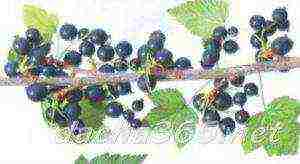 The variety ripens early. The plant is small, moderately spreading, no more than a meter high. The fruits are large, sweet with a delicate skin, the weight of one is from 2.3 to 4 grams. One hundred grams of fruit pulp contains 190 mg of vitamin C and 9.4% sugar. "Summer resident" tolerates frost well and is not prone to diseases - powdery mildew and kidney mites. The volume of the resulting crop is average, from a bush you can collect from 1.5 to 1.9 kg of berries. The flowering period begins in May. Ripe fruits are harvested in the first half of July.
The variety ripens early. The plant is small, moderately spreading, no more than a meter high. The fruits are large, sweet with a delicate skin, the weight of one is from 2.3 to 4 grams. One hundred grams of fruit pulp contains 190 mg of vitamin C and 9.4% sugar. "Summer resident" tolerates frost well and is not prone to diseases - powdery mildew and kidney mites. The volume of the resulting crop is average, from a bush you can collect from 1.5 to 1.9 kg of berries. The flowering period begins in May. Ripe fruits are harvested in the first half of July.
Advantages:
- Large berries;
- Early maturity;
- The variety is not susceptible to the spread of diseases.
Minuses:
- It is recommended to prop up the bushes so that they do not lie on the ground;
- The berries ripen at different times;
- Fruits that are overripe quickly crumble.
"Titania"
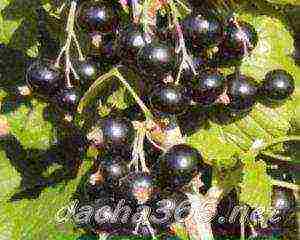 "Titania" has an average ripening period. Medium-sized plant is not very tall. The bushes are thick, quite high up to 1.6 m. The greenish pulp tastes sour-sweet, the skin is dense. The content of vitamin C in 100 grams of fruit is 171 mg, sugar is 8.8%. The variety easily tolerates the cold season and low temperatures. It is not exposed to the spread of powdery mildew.One bush can be harvested from 1.6 to 2.6 kg of the crop. The weight of one berry is from 1 to 2.6 grams. Flowering begins in mid-May. You can harvest the crop in early July.
"Titania" has an average ripening period. Medium-sized plant is not very tall. The bushes are thick, quite high up to 1.6 m. The greenish pulp tastes sour-sweet, the skin is dense. The content of vitamin C in 100 grams of fruit is 171 mg, sugar is 8.8%. The variety easily tolerates the cold season and low temperatures. It is not exposed to the spread of powdery mildew.One bush can be harvested from 1.6 to 2.6 kg of the crop. The weight of one berry is from 1 to 2.6 grams. Flowering begins in mid-May. You can harvest the crop in early July.
Advantages
- The variety is not susceptible to powdery mildew;
- Berries do not crumble for a long time.
Minuses:
- Currants of different sizes;
- The fruits do not ripen for a long time.
"Black Pearl"
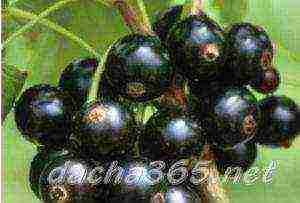 The berries ripen in an average time. The plant is not tall, about 1 - 1.6 m. Fruits of the same size with a dry separation. The pulp is sweetish and sour, the sugar content in 100 grams is 9.3%, ascorbic acid is 134 mg. Self-fertile black pearls tolerate frost well, give a large amount of harvest. Susceptibility to diseases such as powdery mildew is moderate. From one bush per season, you can collect from 3.6 to 4.6 kg of fruit. The weight of one unit is from 1.4 to 1.5 g. Flowering begins in May. The harvest ripens in the middle of summer.
The berries ripen in an average time. The plant is not tall, about 1 - 1.6 m. Fruits of the same size with a dry separation. The pulp is sweetish and sour, the sugar content in 100 grams is 9.3%, ascorbic acid is 134 mg. Self-fertile black pearls tolerate frost well, give a large amount of harvest. Susceptibility to diseases such as powdery mildew is moderate. From one bush per season, you can collect from 3.6 to 4.6 kg of fruit. The weight of one unit is from 1.4 to 1.5 g. Flowering begins in May. The harvest ripens in the middle of summer.
Advantages:
- Good productivity;
- Large fruits;
- Berries of the same size;
- Carries transportation easily;
- Low temperature resistance.
Flaws:
- Average susceptibility to powdery mildew disease.
"Pygmy"
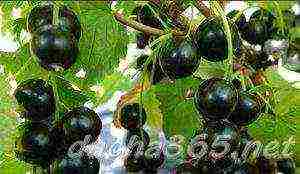 The delicacy variety has an average ripening period. The bushes are spreading, low. The currant is large, with soft skin and delicious dessert pulp. The pulp is rich in vitamin C and other beneficial substances. 100 grams of berries contain 9.5% sugar and 151 mg of ascorbic acid. "Pygmy" refers to self-fertile species, tolerates frost well. Not susceptible to diseases such as anthracnose and powdery mildew. From 1.5 to 5.8 kg of currants are harvested from the bush. Flowering begins in mid-May, and ripe fruits appear in the second half of July.
The delicacy variety has an average ripening period. The bushes are spreading, low. The currant is large, with soft skin and delicious dessert pulp. The pulp is rich in vitamin C and other beneficial substances. 100 grams of berries contain 9.5% sugar and 151 mg of ascorbic acid. "Pygmy" refers to self-fertile species, tolerates frost well. Not susceptible to diseases such as anthracnose and powdery mildew. From 1.5 to 5.8 kg of currants are harvested from the bush. Flowering begins in mid-May, and ripe fruits appear in the second half of July.
Advantages:
- It tolerates frost well;
- Gives a rich harvest;
- Large berries.
Minuses:
- Currants differ in weight and size;
- Resistance to the appearance of a kidney mite is average.
Late, large varieties of black currant
"Daughter"
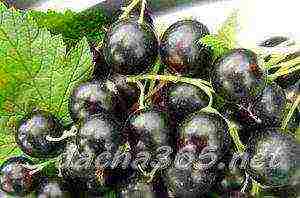 Differs in late ripening. The bushes are not spreading, no more than a meter high. The fruits are large, with a dry separation, the weight of the fruits is from 1 to 2.4 g. The taste of the pulp is sweet and sour, 100 grams of currants contain 160 mg of vitamin C and 7.6% sugar. "Daughter" perfectly tolerates frost and drought. The variety is not susceptible to the appearance of a kidney mite. Medium powdery mildew resistance. From one bush, you can collect from 3 to 4 kg of black currant. Flowering begins in late spring, ripe fruits can be harvested in the first half of August.
Differs in late ripening. The bushes are not spreading, no more than a meter high. The fruits are large, with a dry separation, the weight of the fruits is from 1 to 2.4 g. The taste of the pulp is sweet and sour, 100 grams of currants contain 160 mg of vitamin C and 7.6% sugar. "Daughter" perfectly tolerates frost and drought. The variety is not susceptible to the appearance of a kidney mite. Medium powdery mildew resistance. From one bush, you can collect from 3 to 4 kg of black currant. Flowering begins in late spring, ripe fruits can be harvested in the first half of August.
Advantages:
- Productivity;
- Good quality berries.
Flaws:
- Medium powdery mildew resistance.
"Vologda"
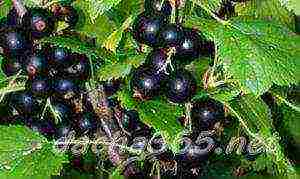 Maturation occurs late. Medium-sized plant with sprawling bushes. The fruits are large, with a dry separation to the taste of sour-sweet. The pulp contains 7.6% sugar per 100 grams and 176 mg of vitamin C. "Vologda" tolerates low temperatures well, but spring frosts can have a negative effect on currants. Not susceptible to the emergence and spread of diseases and viruses. From one bush, 3.4 to 4 kg of ripe fruits are harvested. The weight of one unit is 1.5 - 2.3 g. The flowering period begins at the end of May. A ripe crop can be harvested in the first half of August.
Maturation occurs late. Medium-sized plant with sprawling bushes. The fruits are large, with a dry separation to the taste of sour-sweet. The pulp contains 7.6% sugar per 100 grams and 176 mg of vitamin C. "Vologda" tolerates low temperatures well, but spring frosts can have a negative effect on currants. Not susceptible to the emergence and spread of diseases and viruses. From one bush, 3.4 to 4 kg of ripe fruits are harvested. The weight of one unit is 1.5 - 2.3 g. The flowering period begins at the end of May. A ripe crop can be harvested in the first half of August.
Advantages:
- High productivity;
- Large berries;
- It tolerates diseases well.
Minuses:
- The plant takes up a lot of space due to the large bushes;
- Needs additional supports.
"Lazy person"
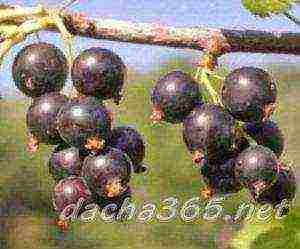 Maturation occurs late. Bushes of the plant are dense and vigorous, height from 1.6 to 1.9 m. Fruits are large, round in shape. The pulp is sweet, contains about 118 mg of vitamin C per 100 g and 8.9% sugar. "Bummer" tolerates low temperatures well, is self-fertile. Not susceptible to the spread of diseases such as terry, anthracnose. Has medium resistance to kidney mites and powdery mildew. From one bush per season, you can get from 1.9 to 2.3 kg of currants. The weight of one unit is from 2 to 3 grams. The flowering period begins in late spring, the harvest ripens in early August.
Maturation occurs late. Bushes of the plant are dense and vigorous, height from 1.6 to 1.9 m. Fruits are large, round in shape. The pulp is sweet, contains about 118 mg of vitamin C per 100 g and 8.9% sugar. "Bummer" tolerates low temperatures well, is self-fertile. Not susceptible to the spread of diseases such as terry, anthracnose. Has medium resistance to kidney mites and powdery mildew. From one bush per season, you can get from 1.9 to 2.3 kg of currants. The weight of one unit is from 2 to 3 grams. The flowering period begins in late spring, the harvest ripens in early August.
Advantages:
- Not susceptible to the spread of diseases and viruses;
- Has a dessert taste.
Minuses:
- Productivity of different volumes;
- Maturation at different times.
Conclusion
Reviews of summer residents and experienced specialists in the field of breeding were very useful in collecting information about the best varieties of black currant. When choosing a variety that will later be grown on a personal garden plot or vegetable garden, one should pay attention not only to the taste and sweetness of the fruits, but also to the volume of the harvest, the rate of ripening and resistance to unfavorable climatic conditions and diseases. For more information on the representatives of each variety, stay tuned for our new articles.
Watch the video! The best varieties of CURRANT to replace old bushes
